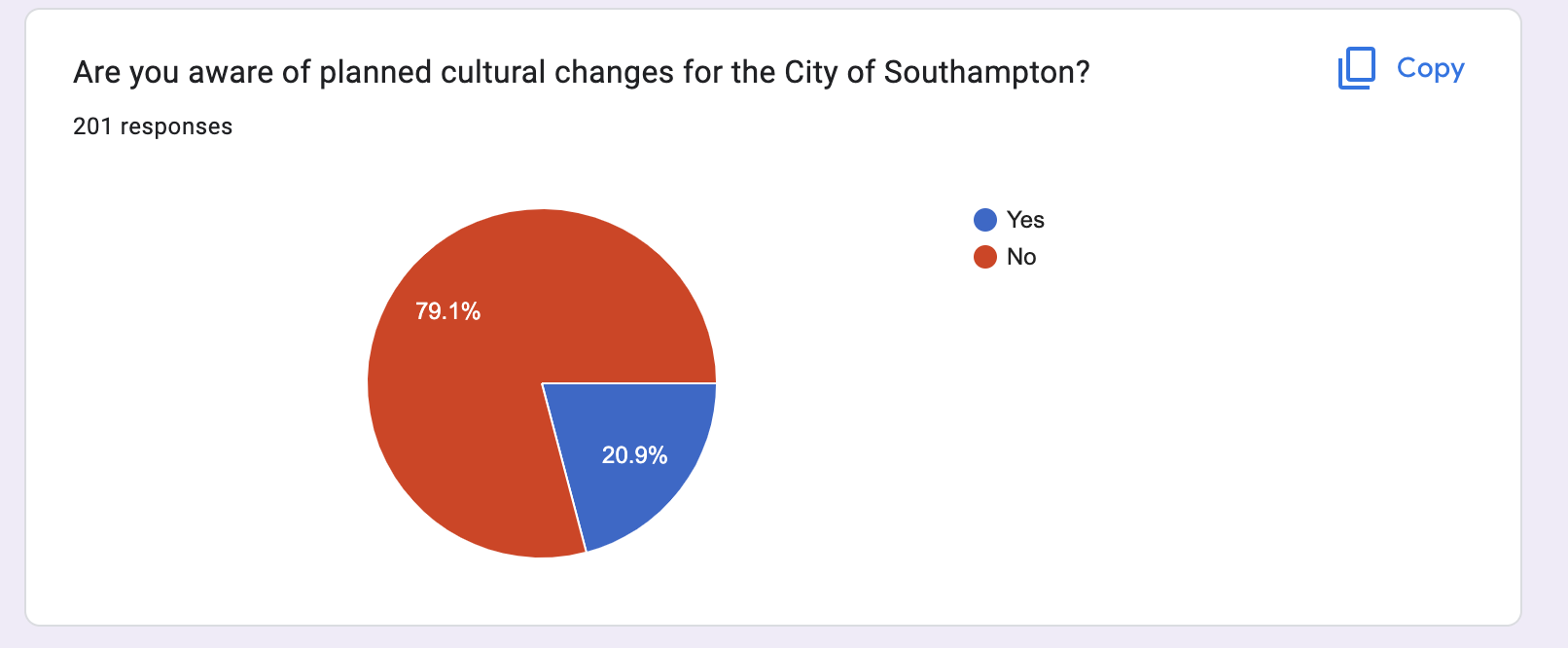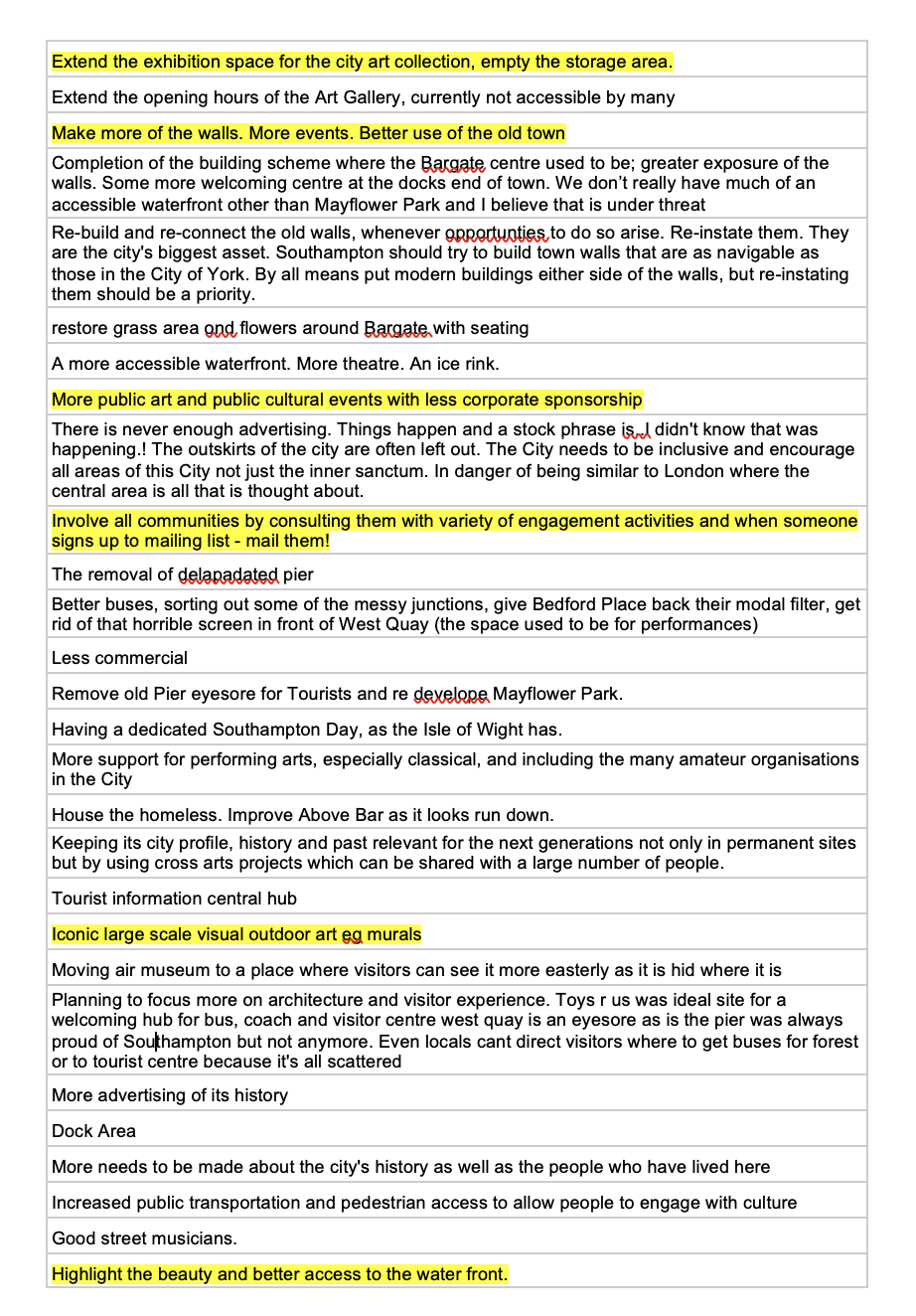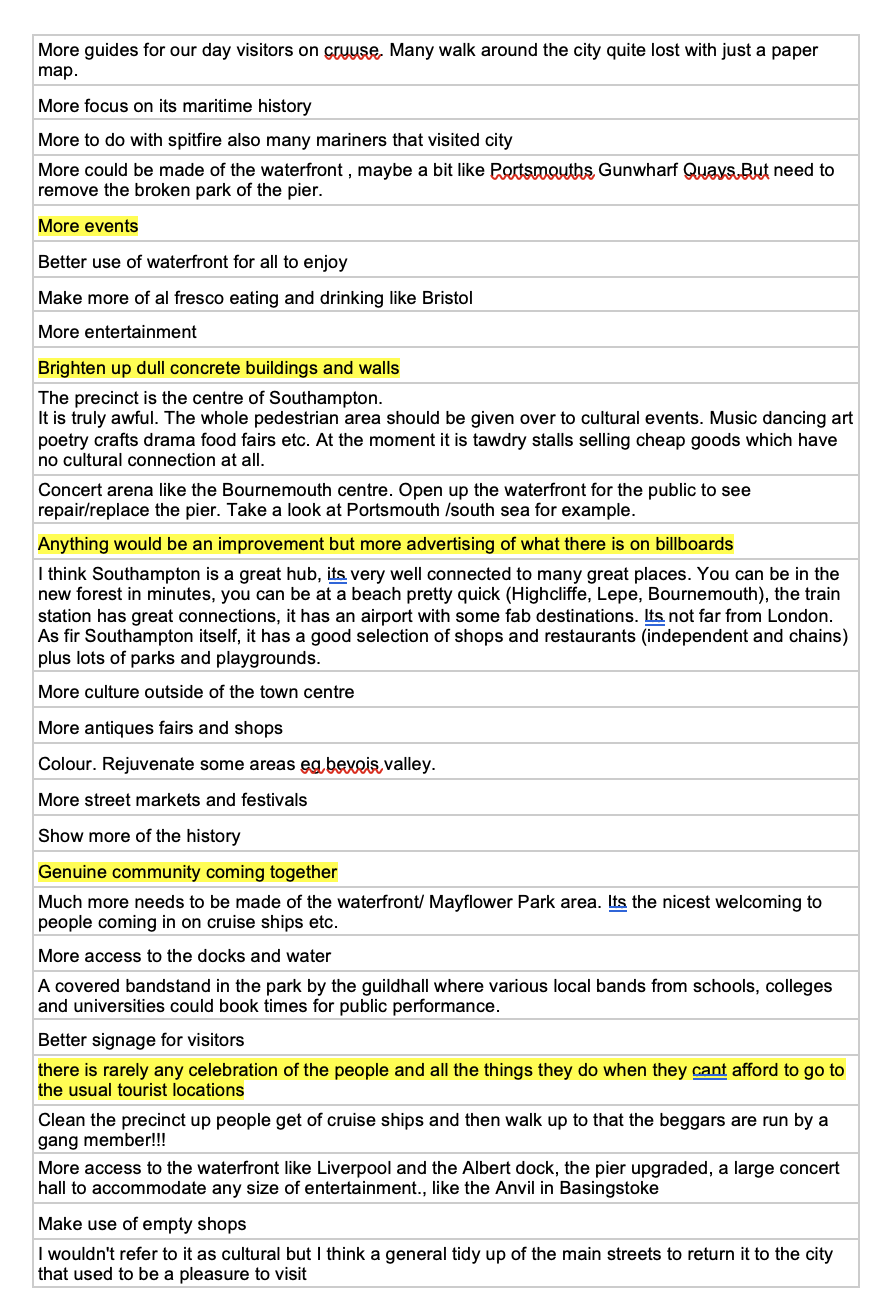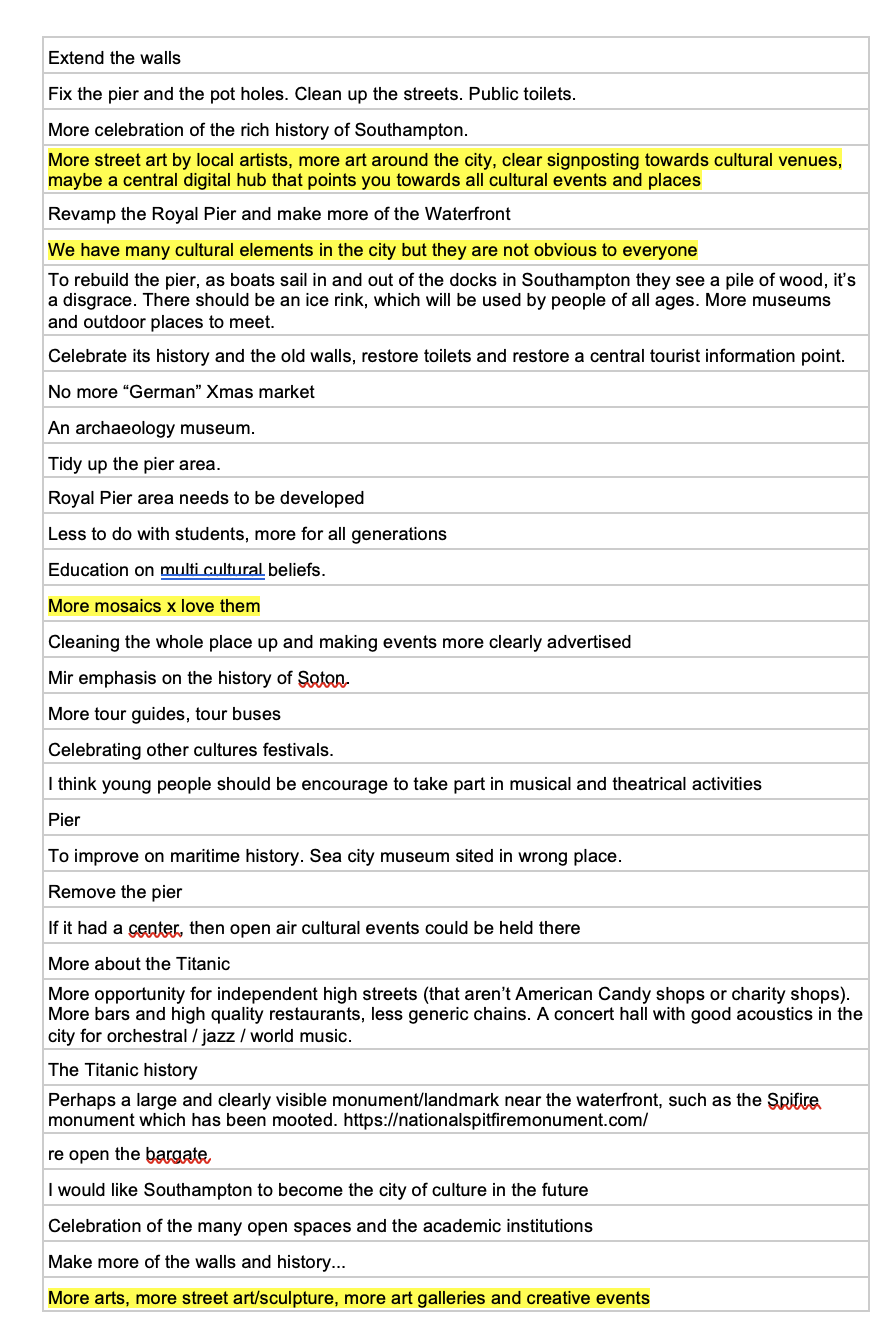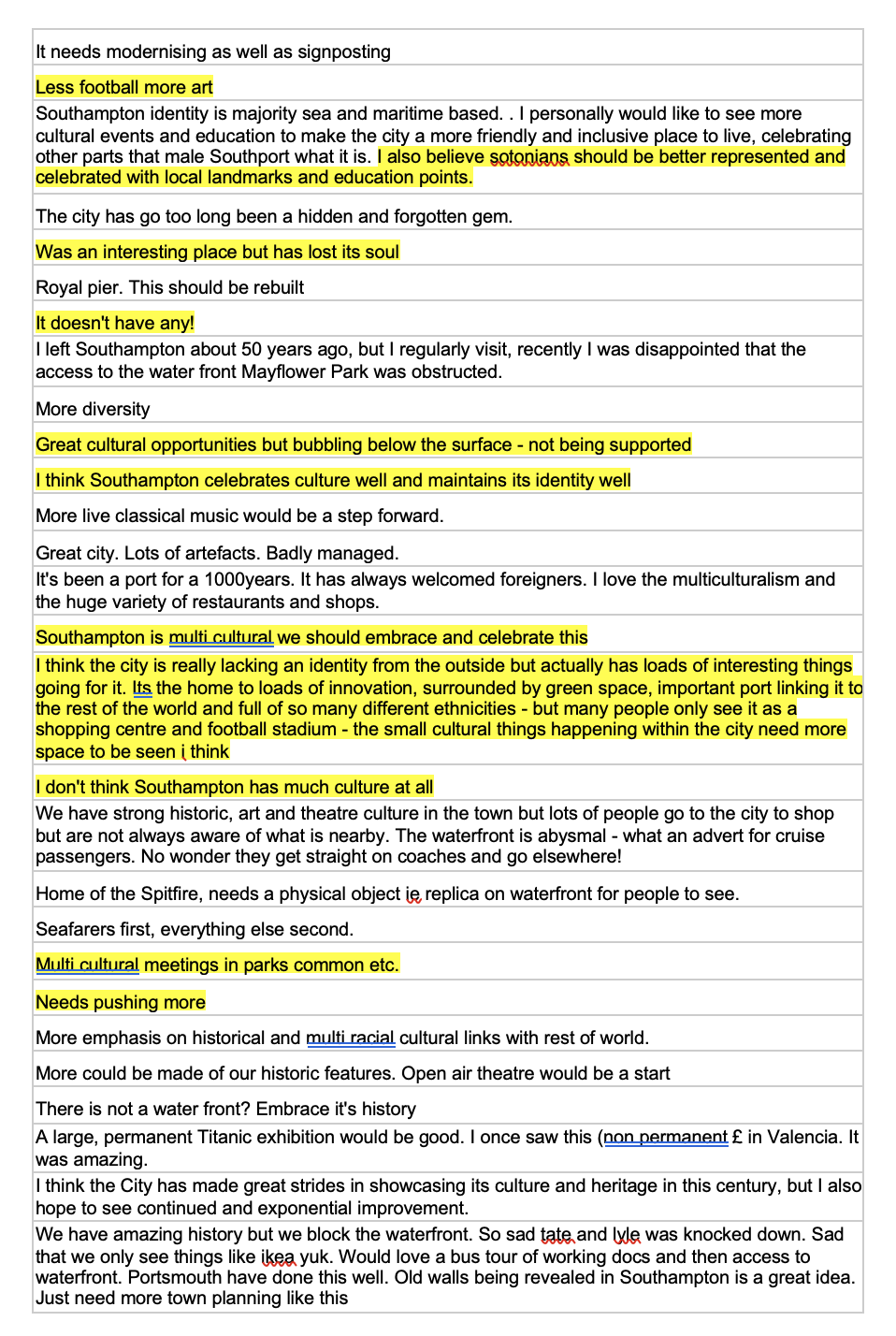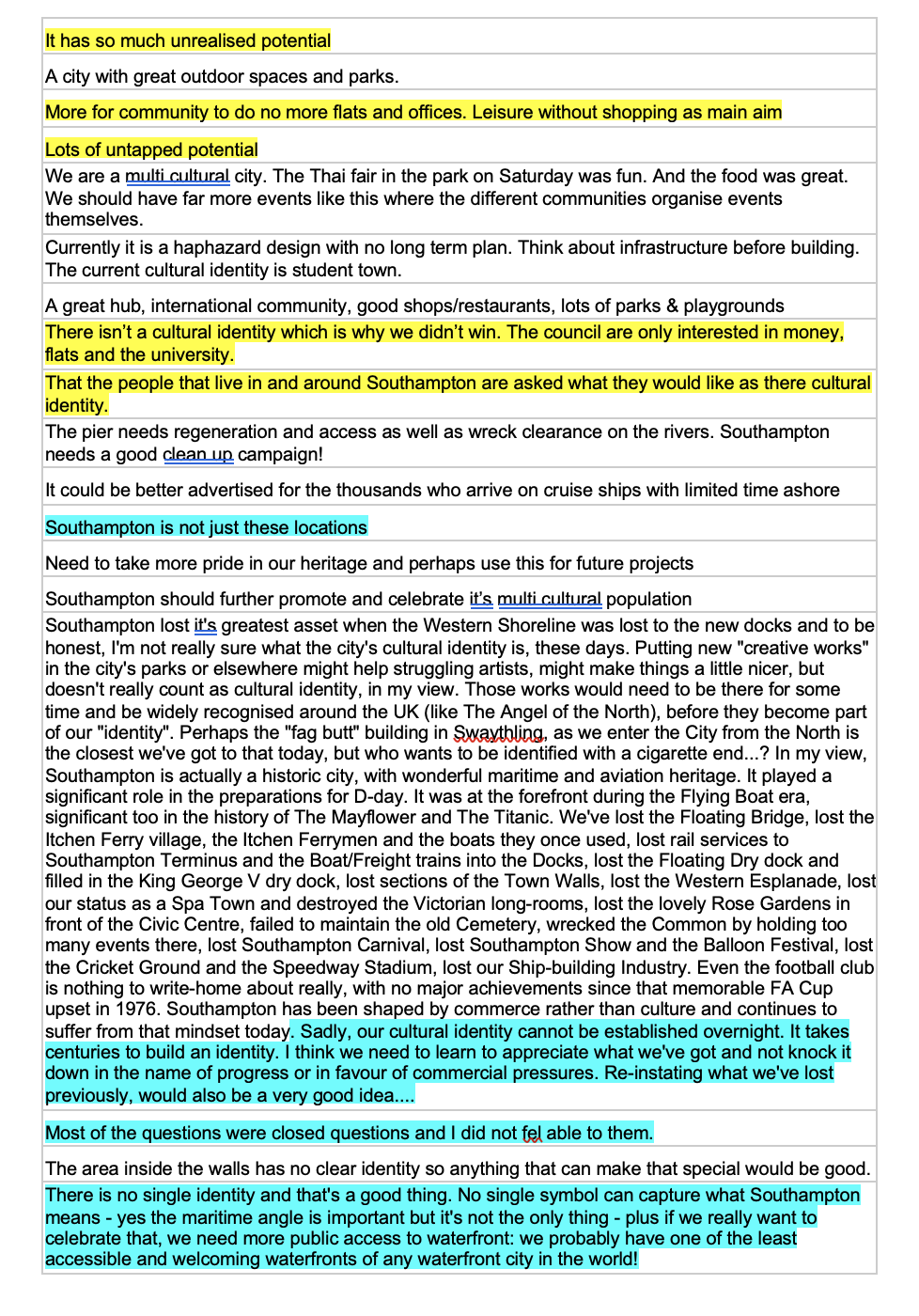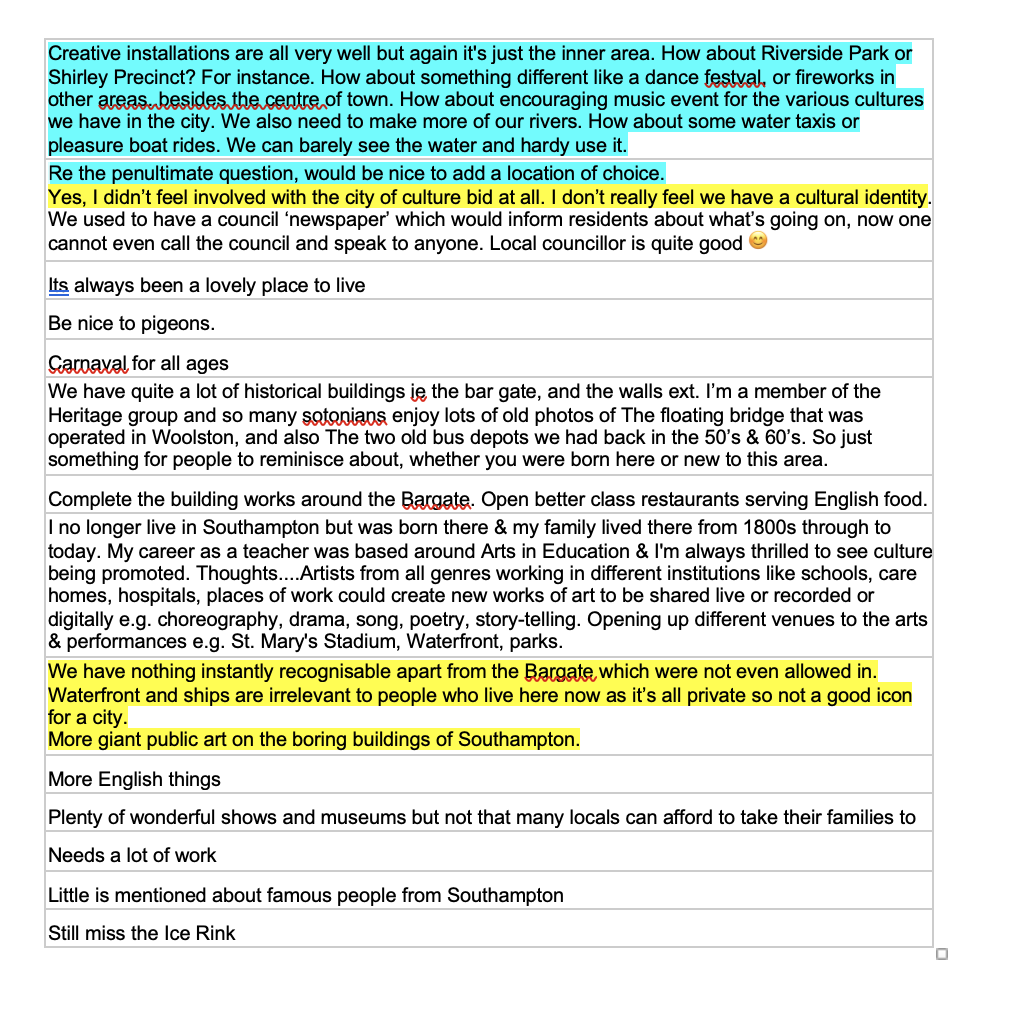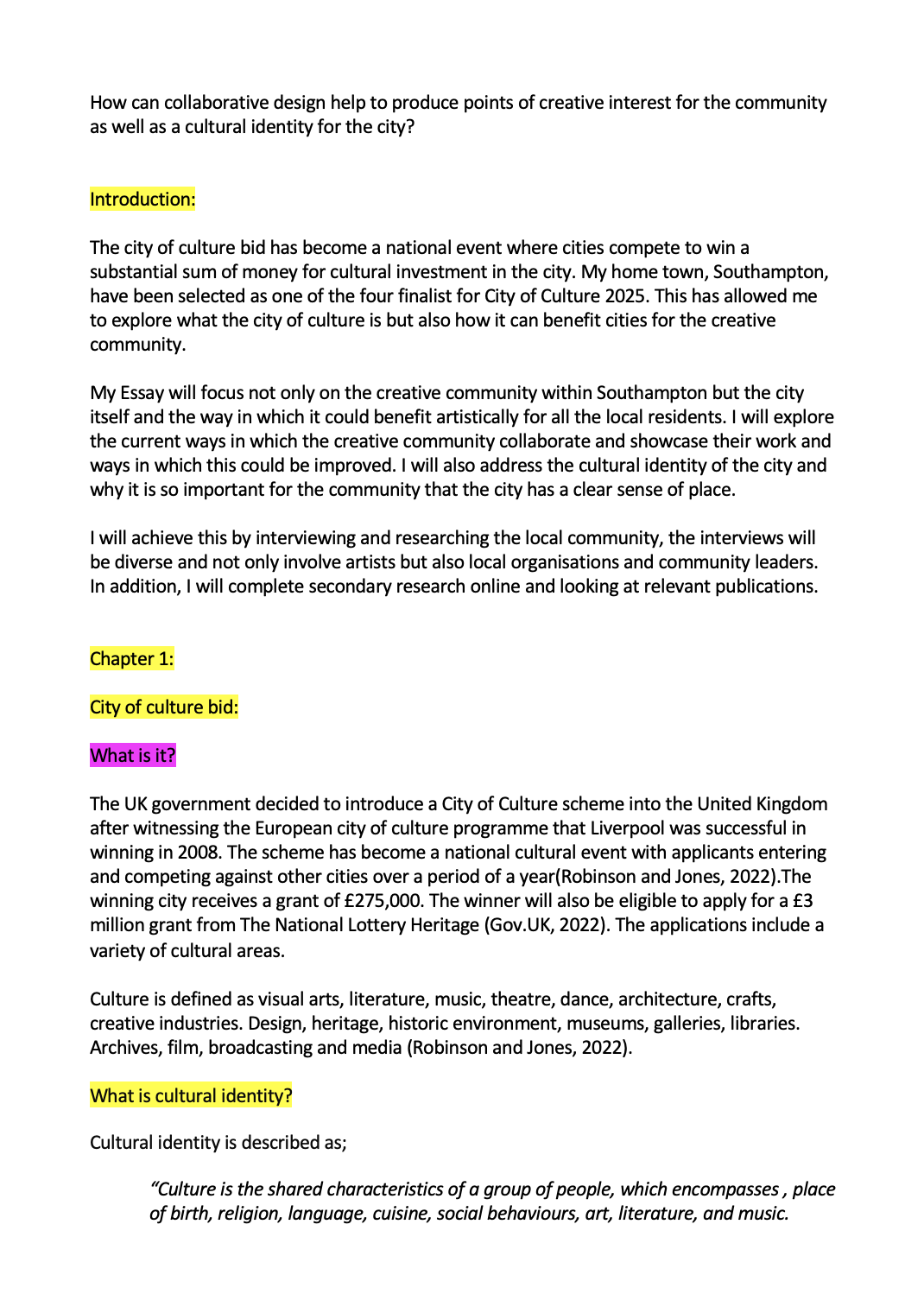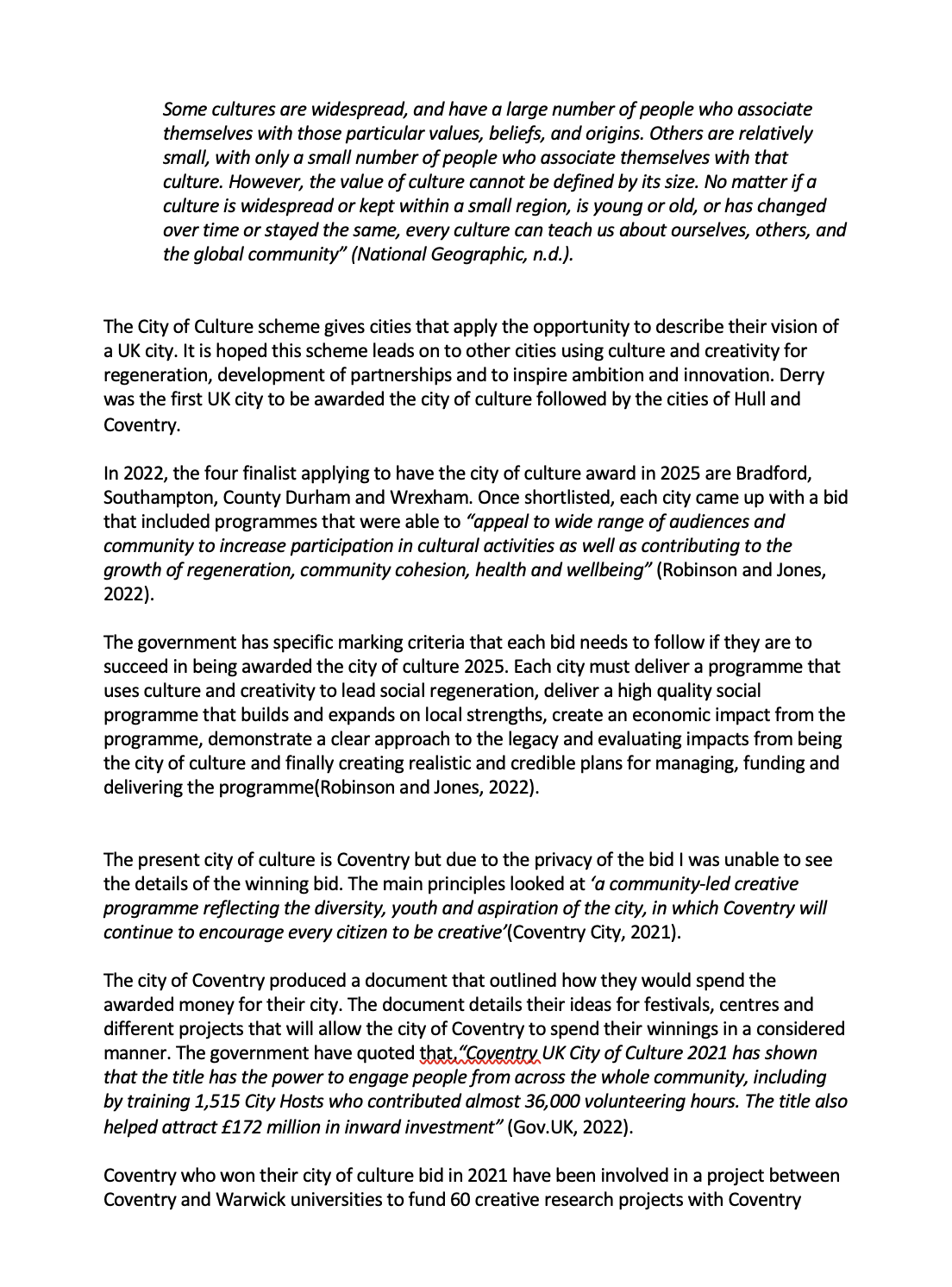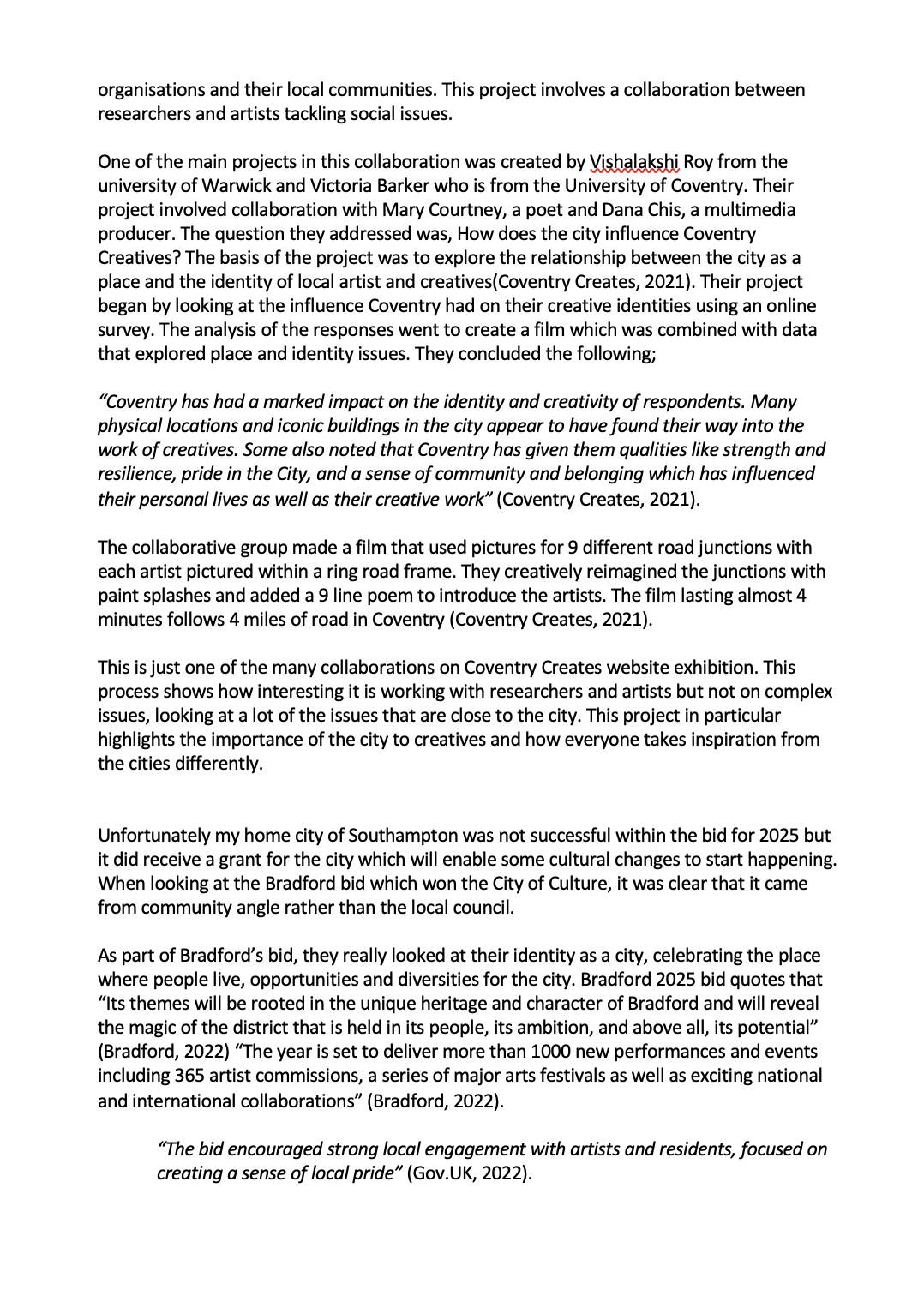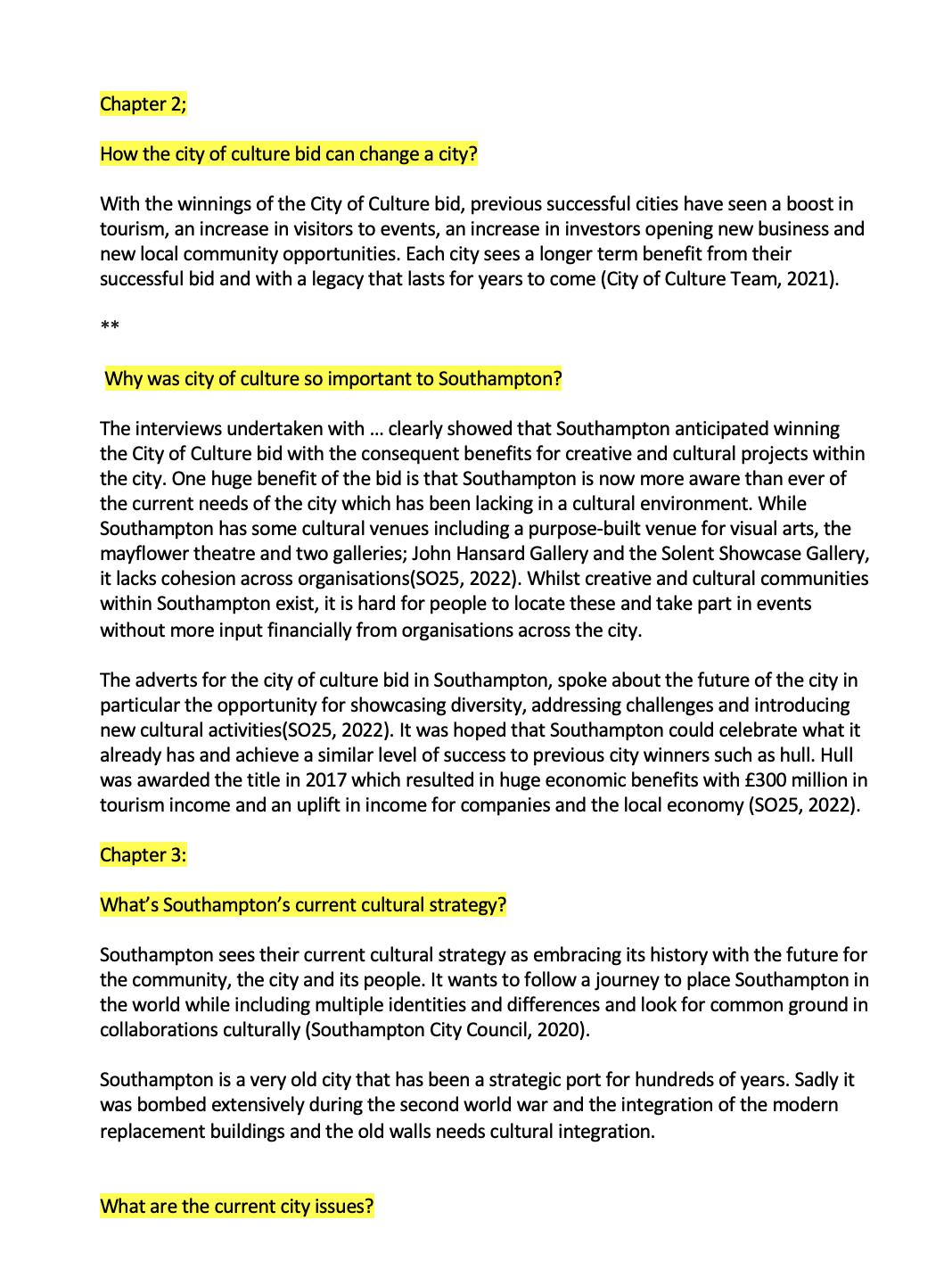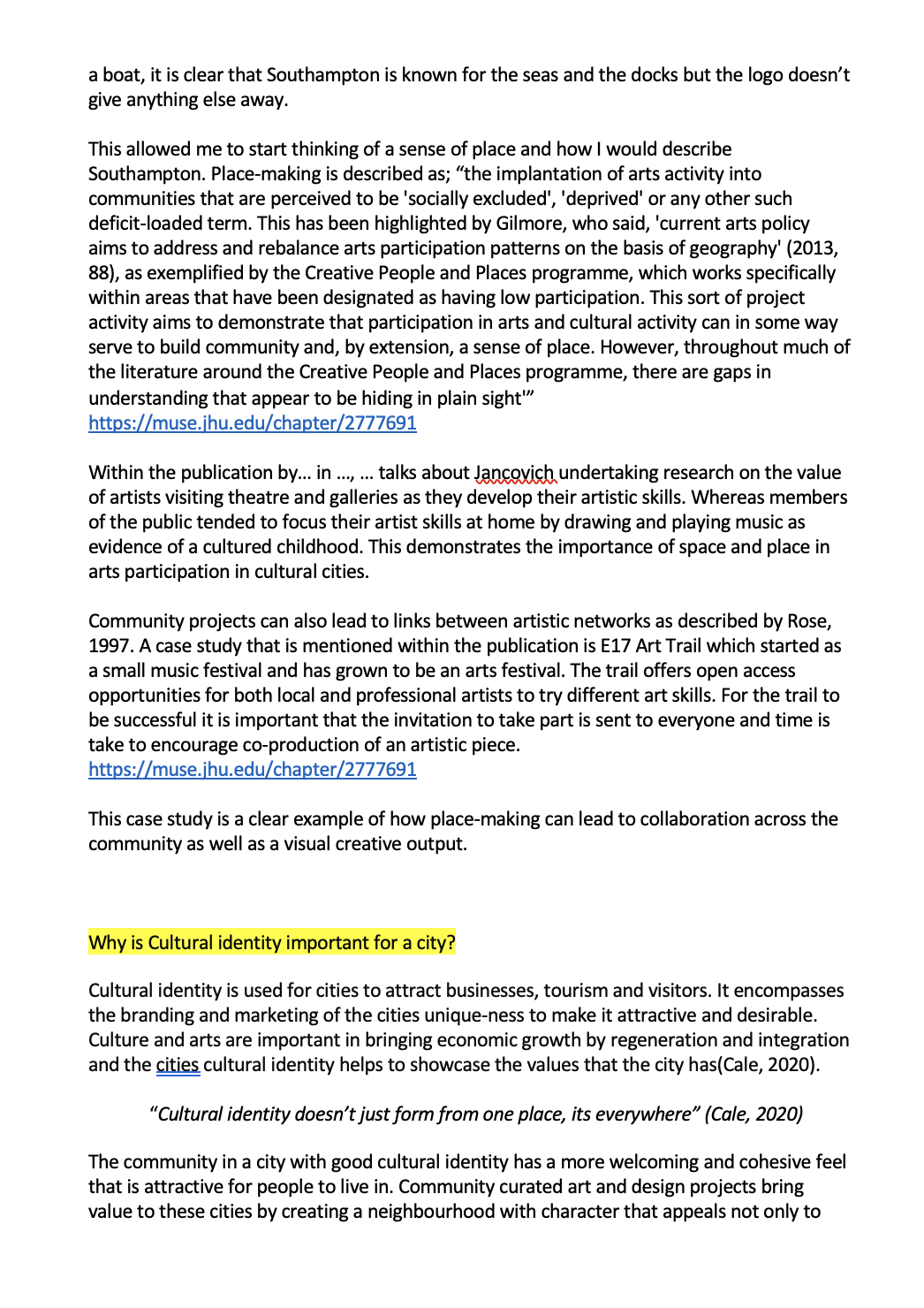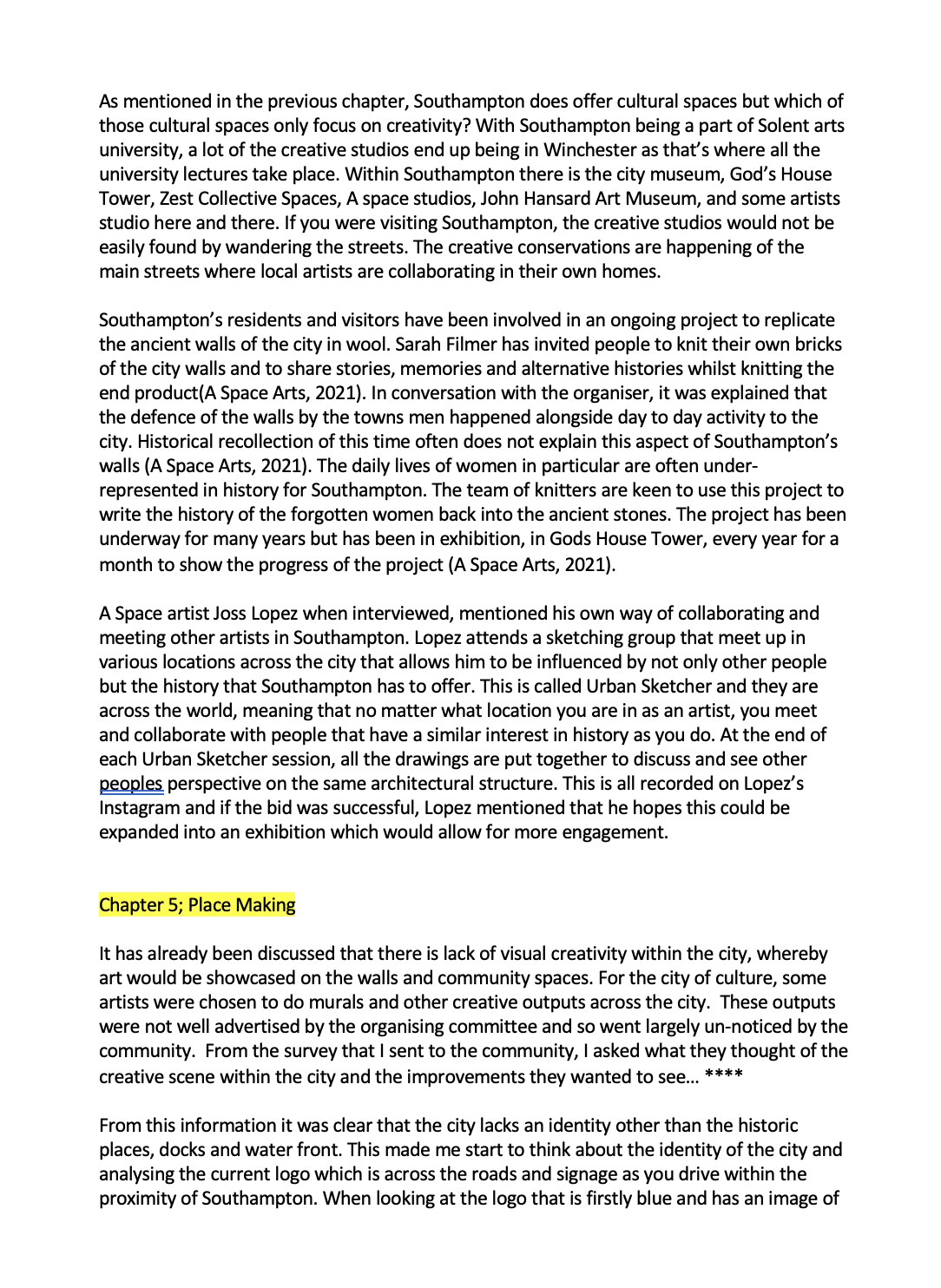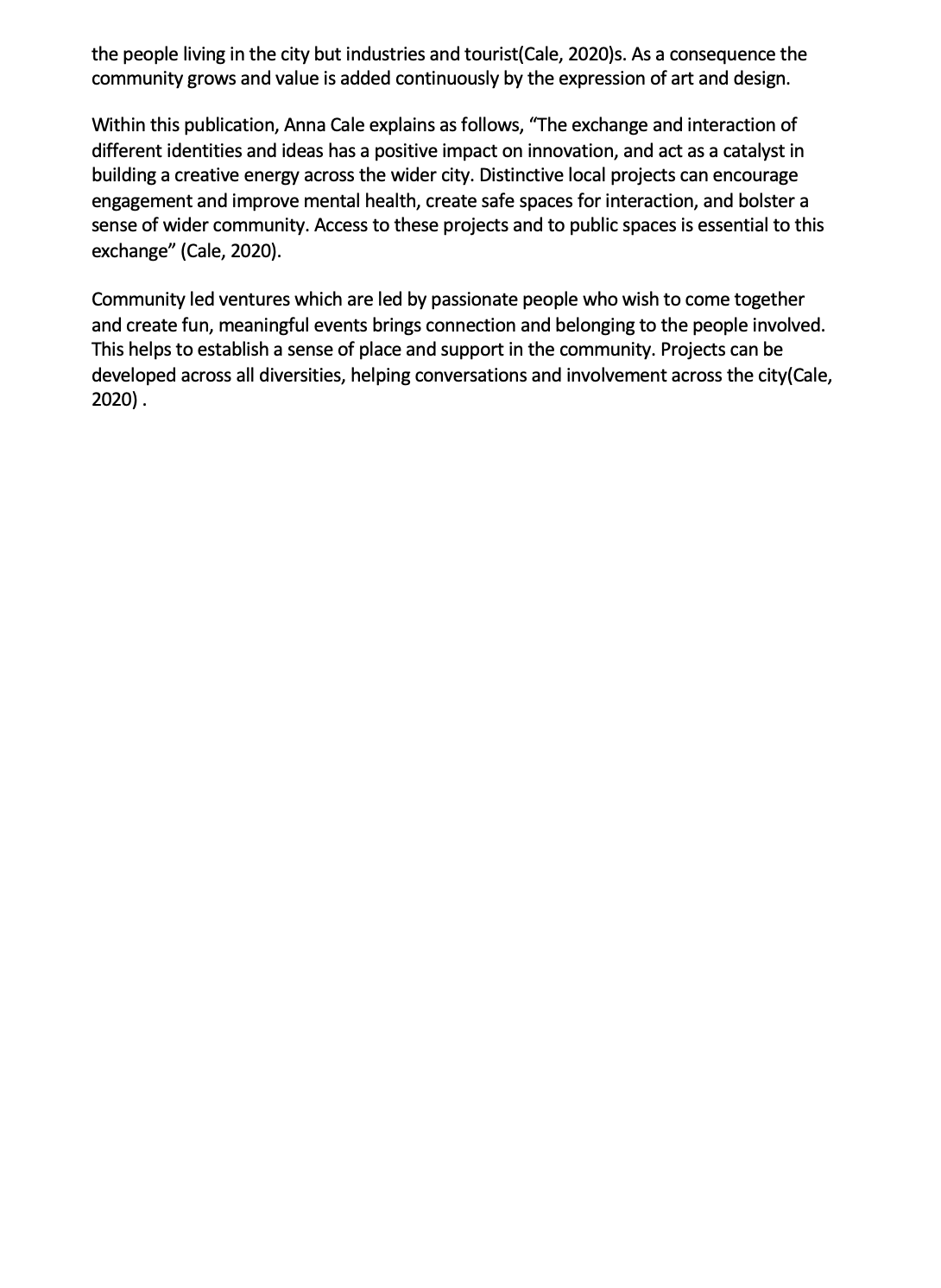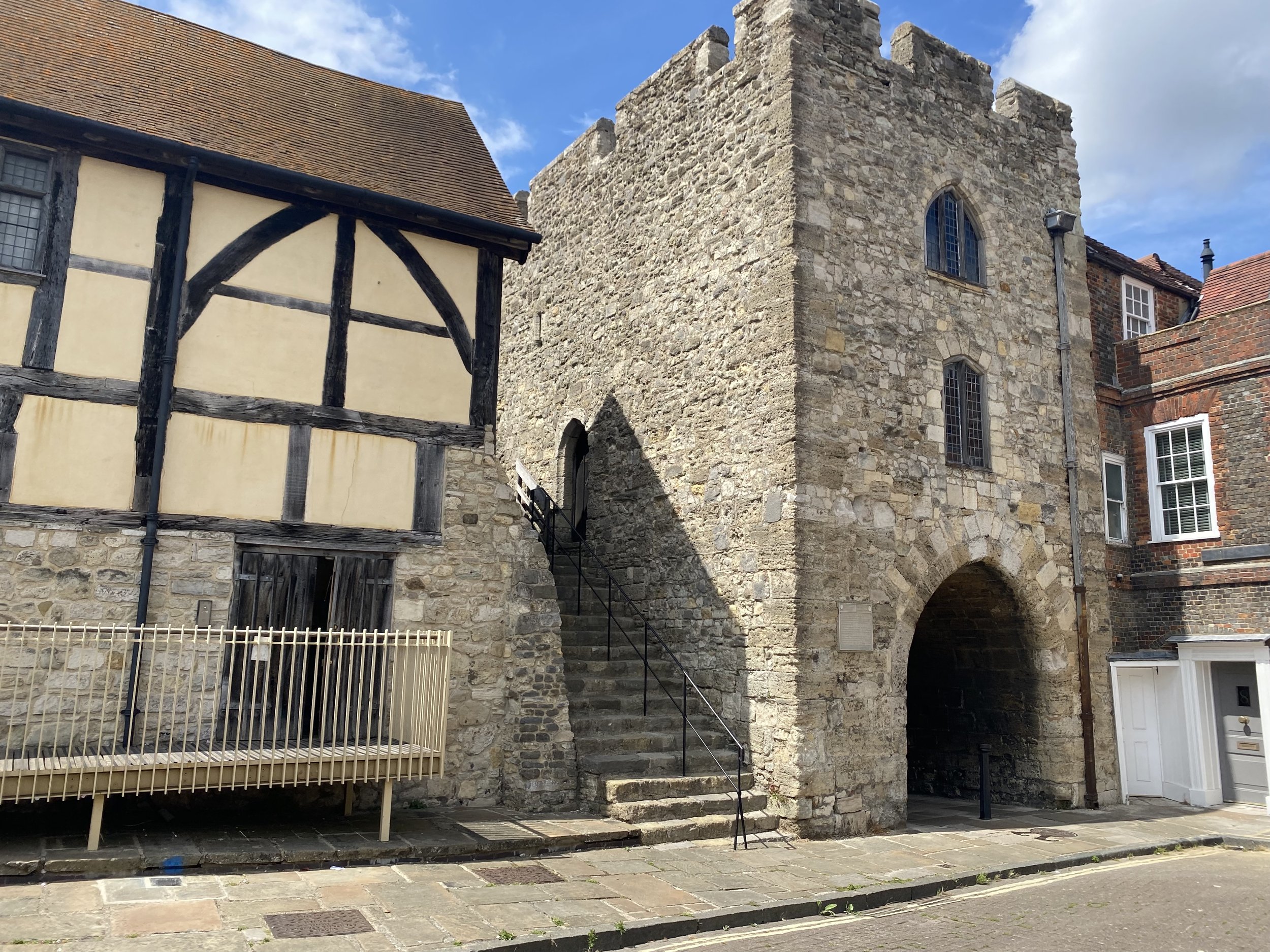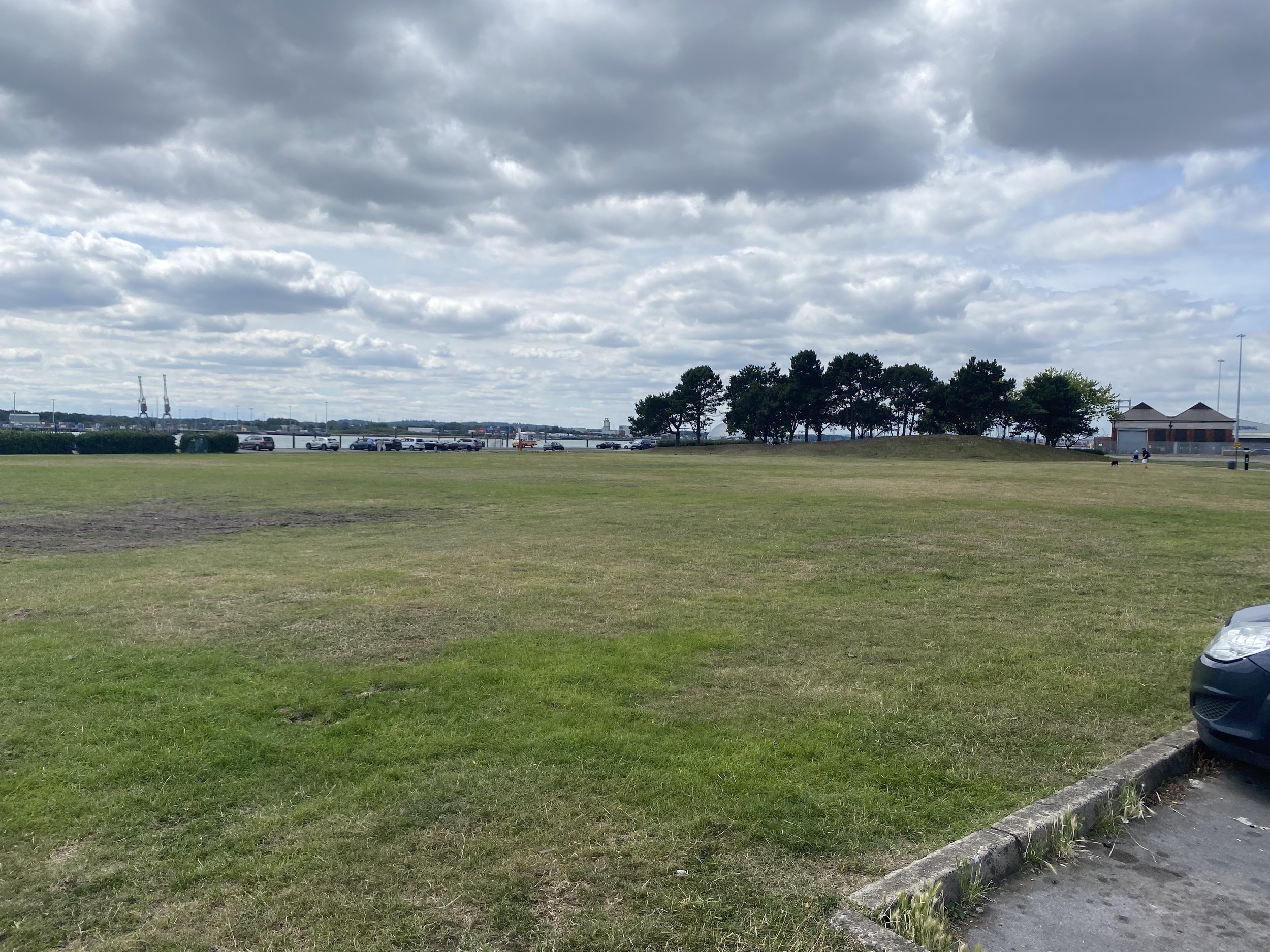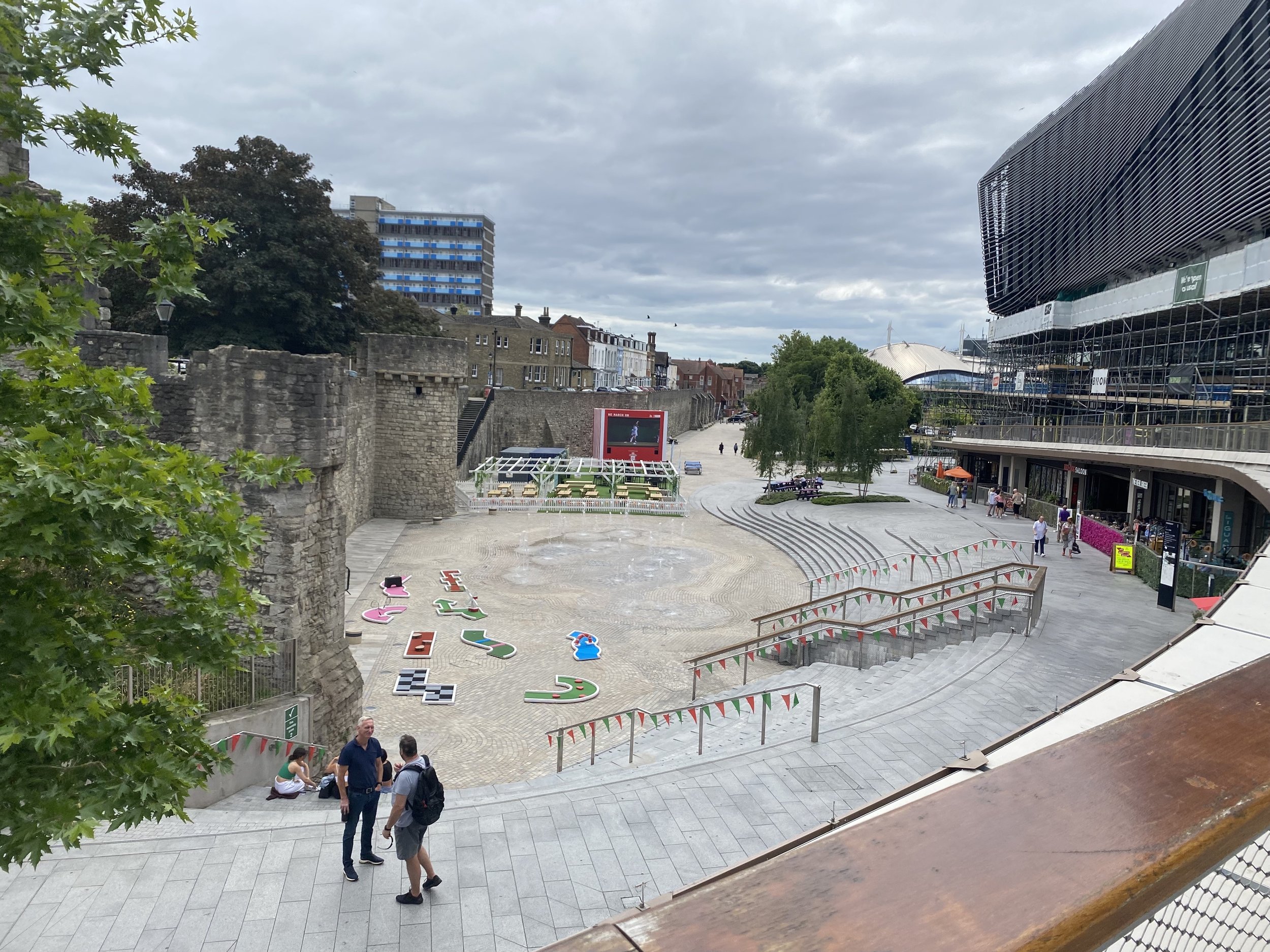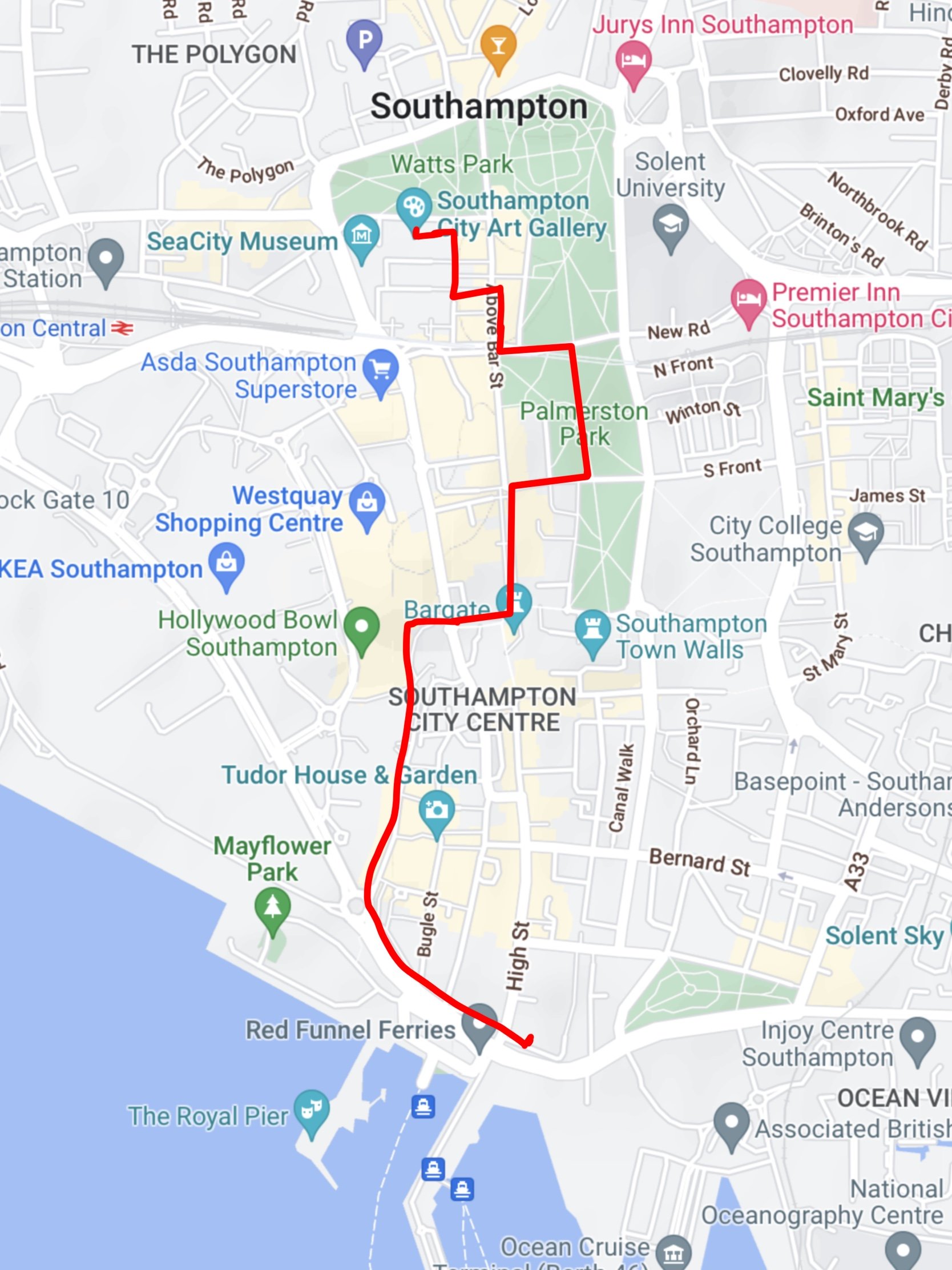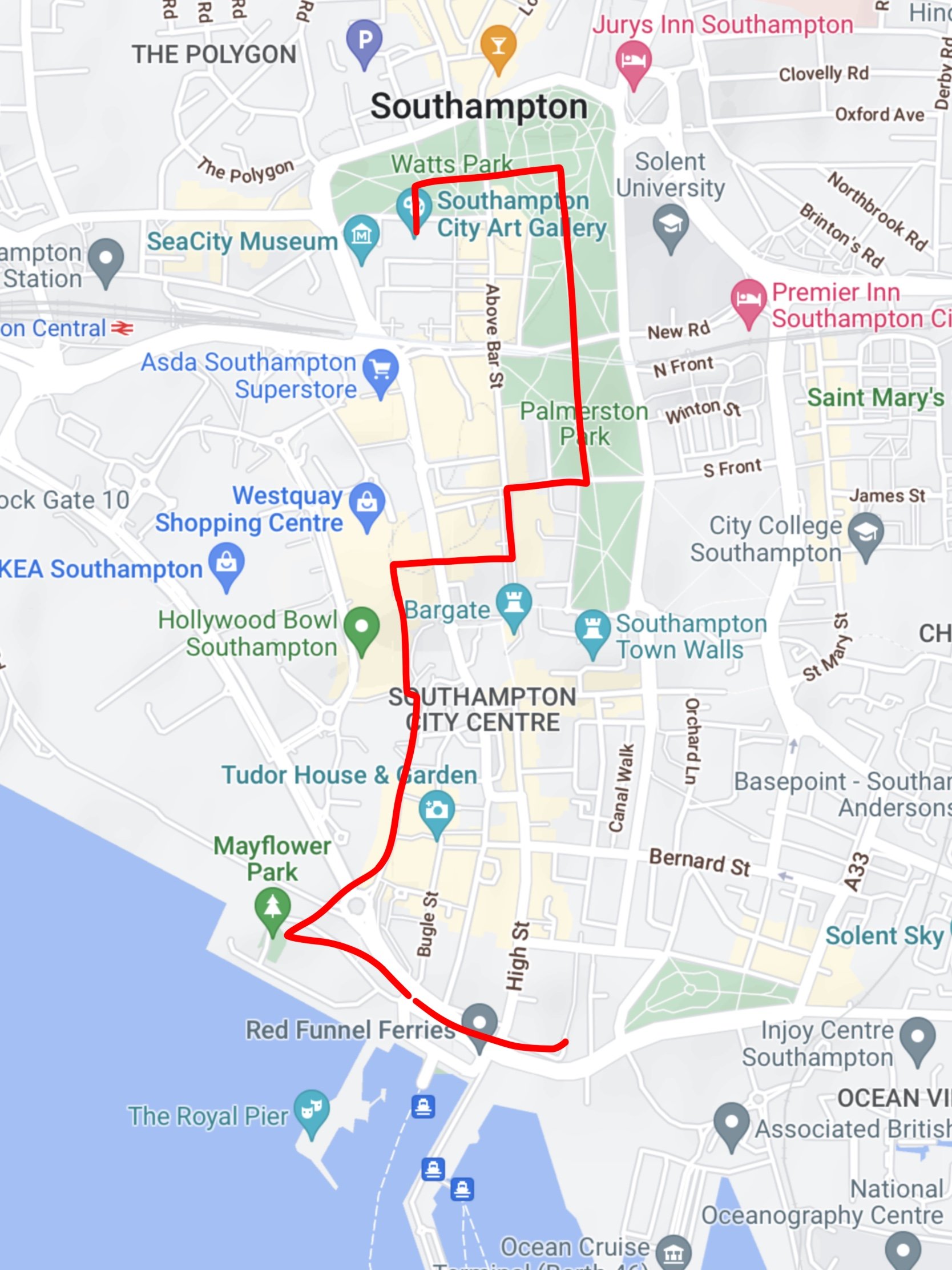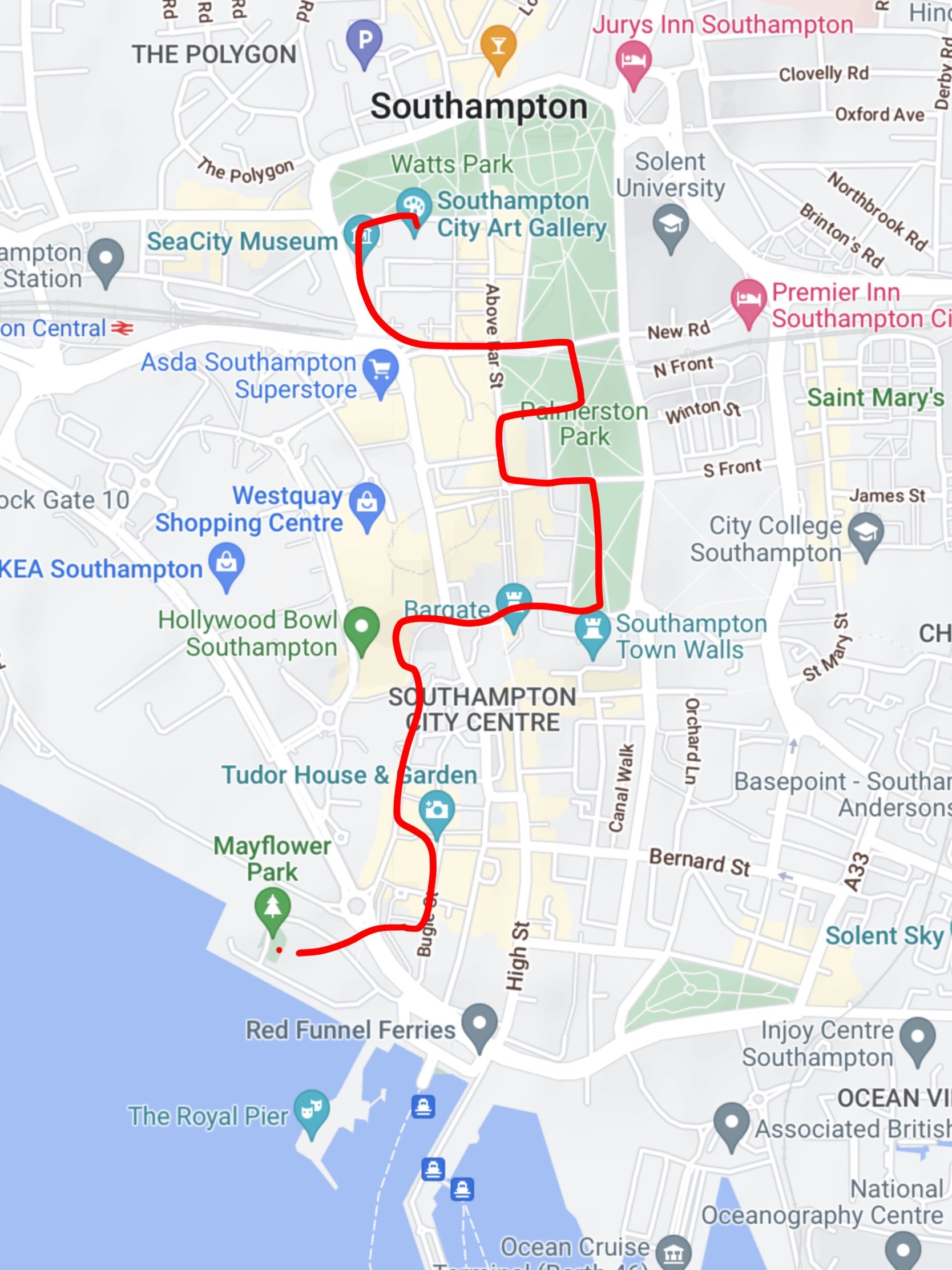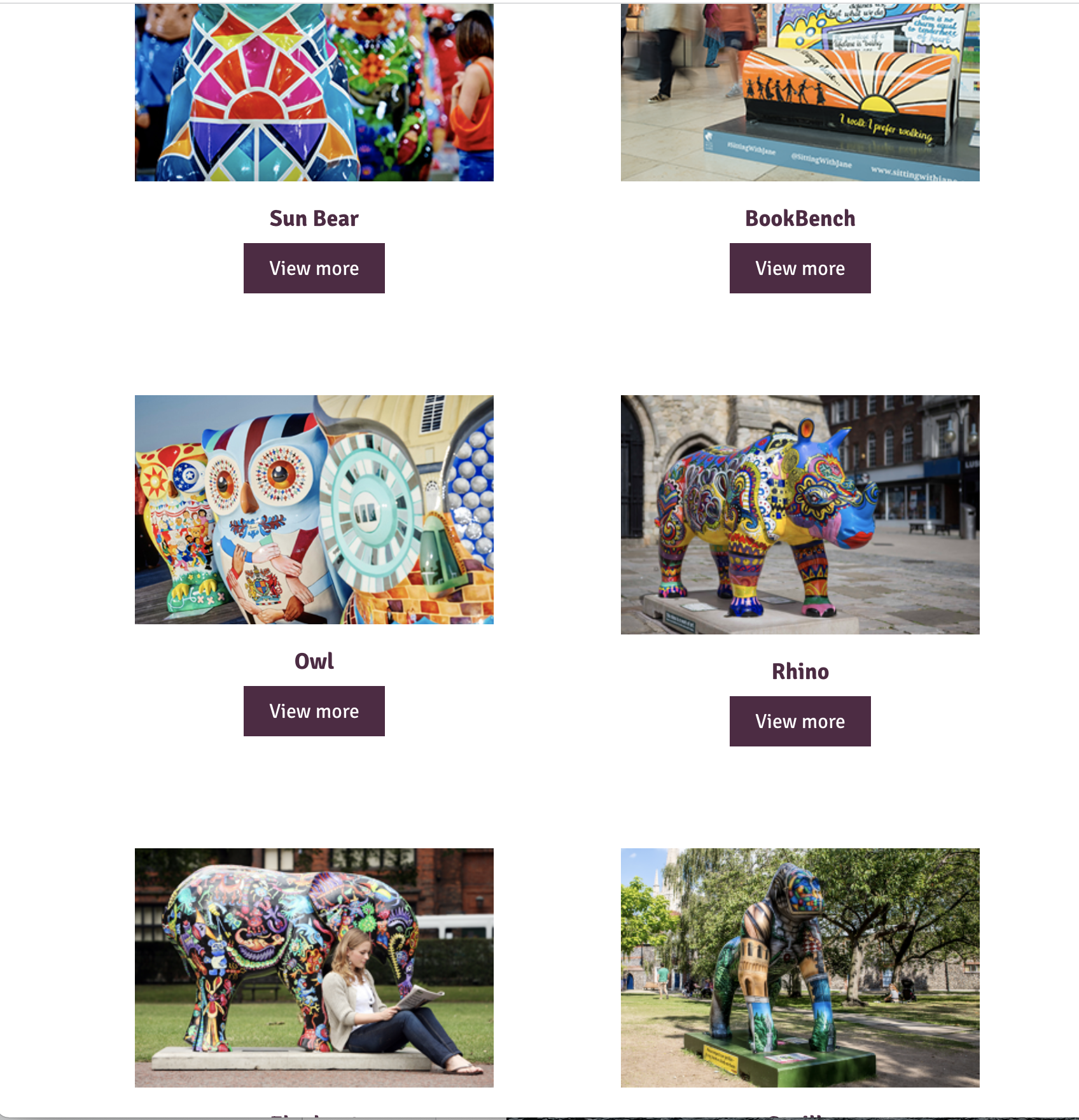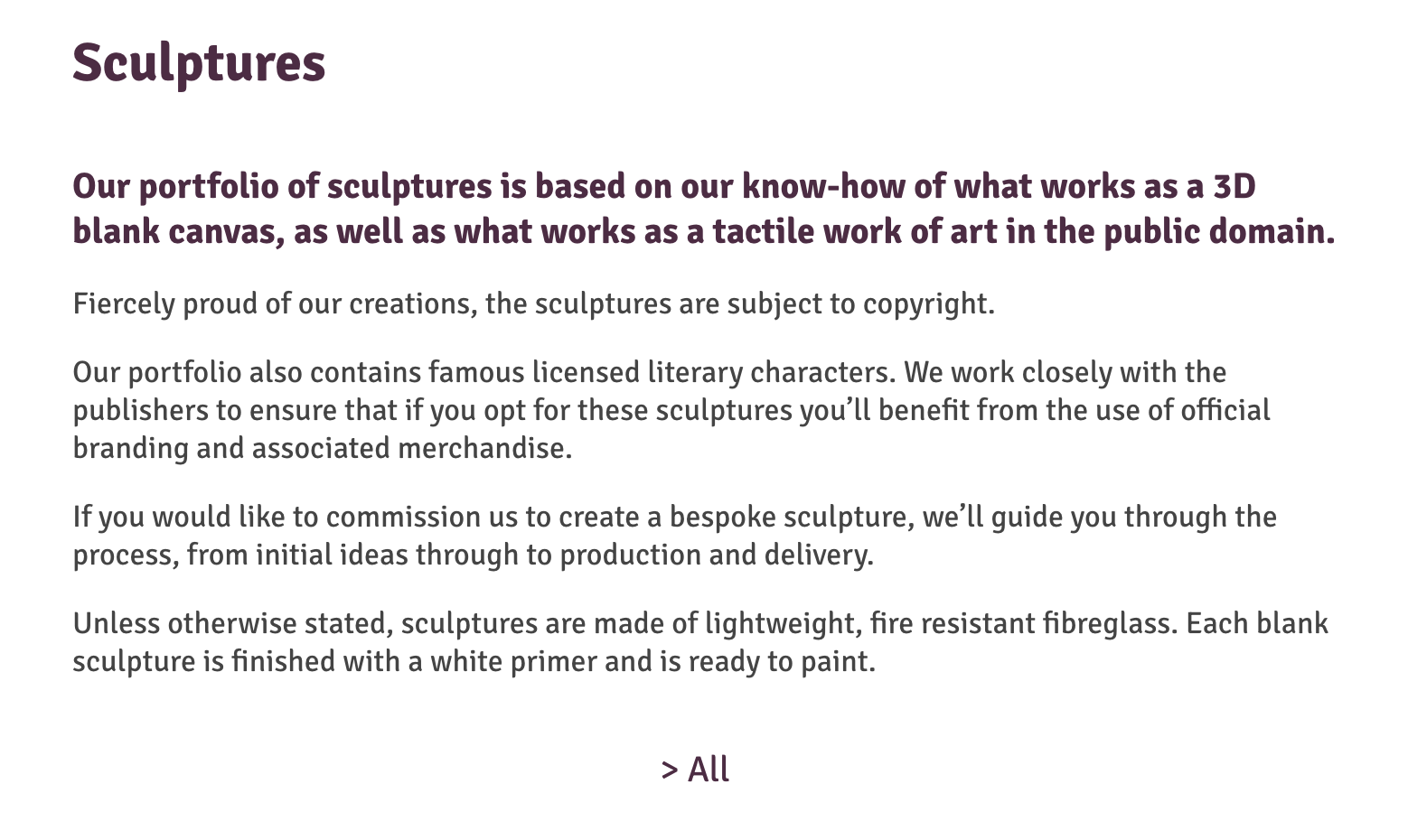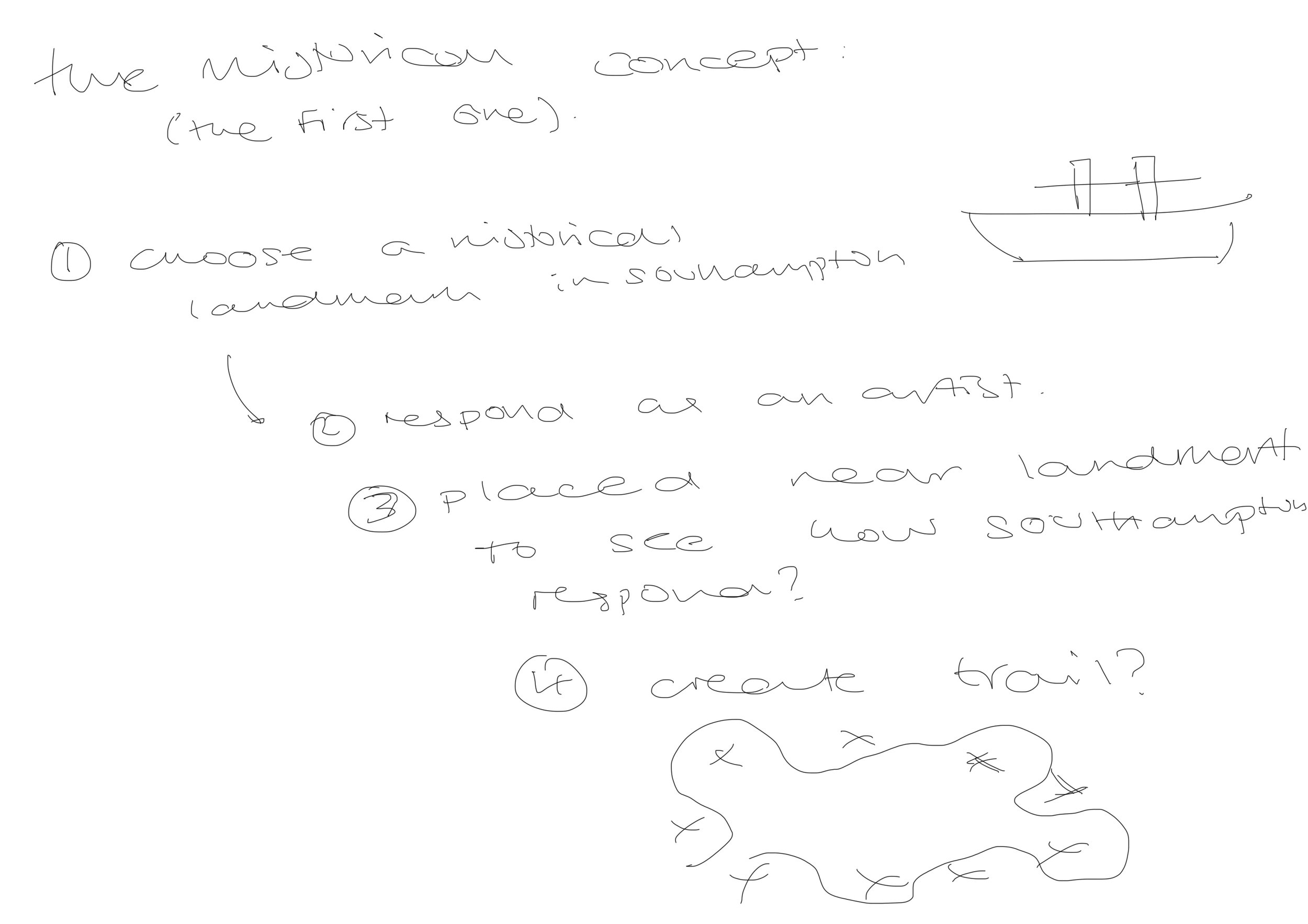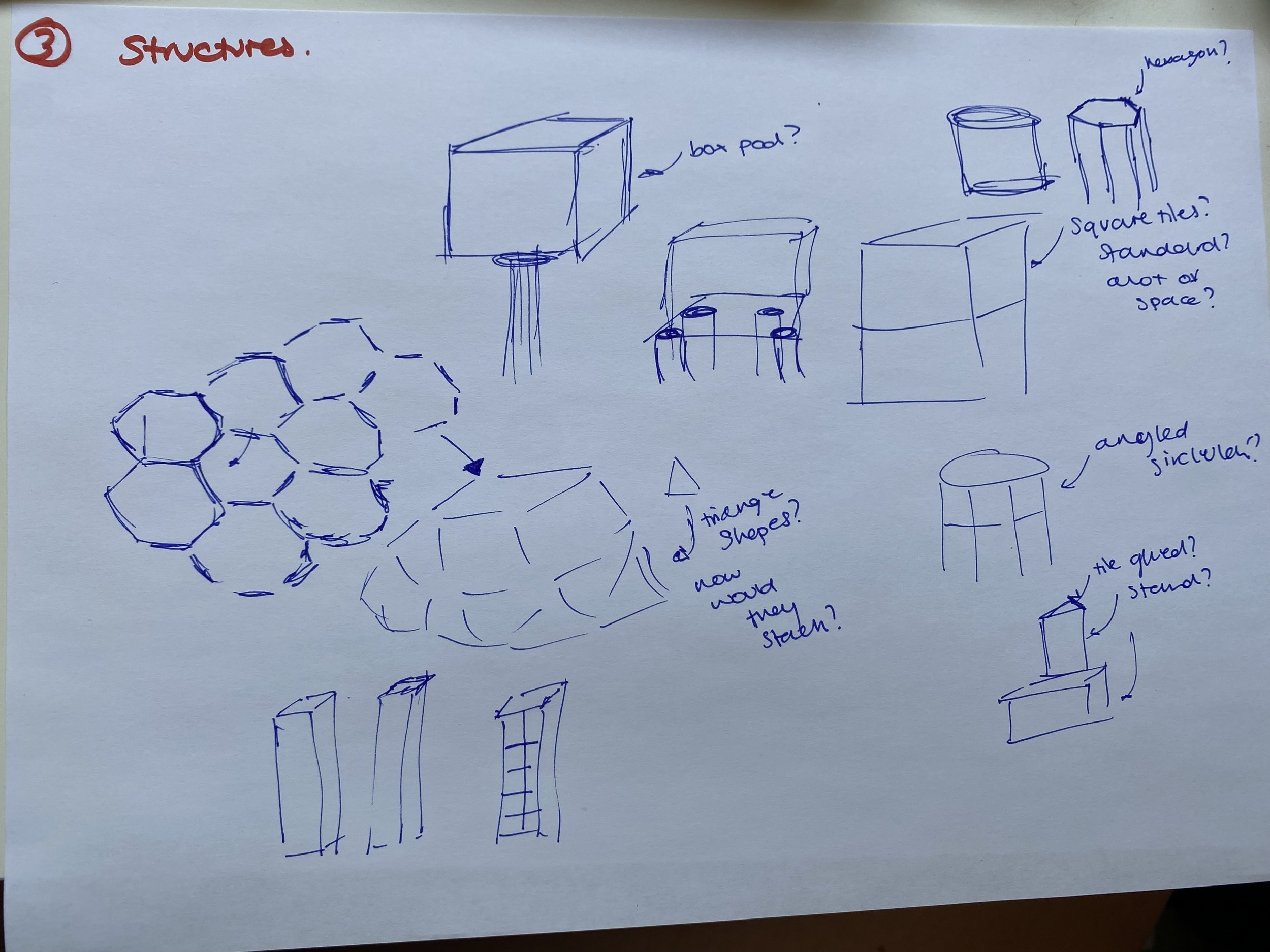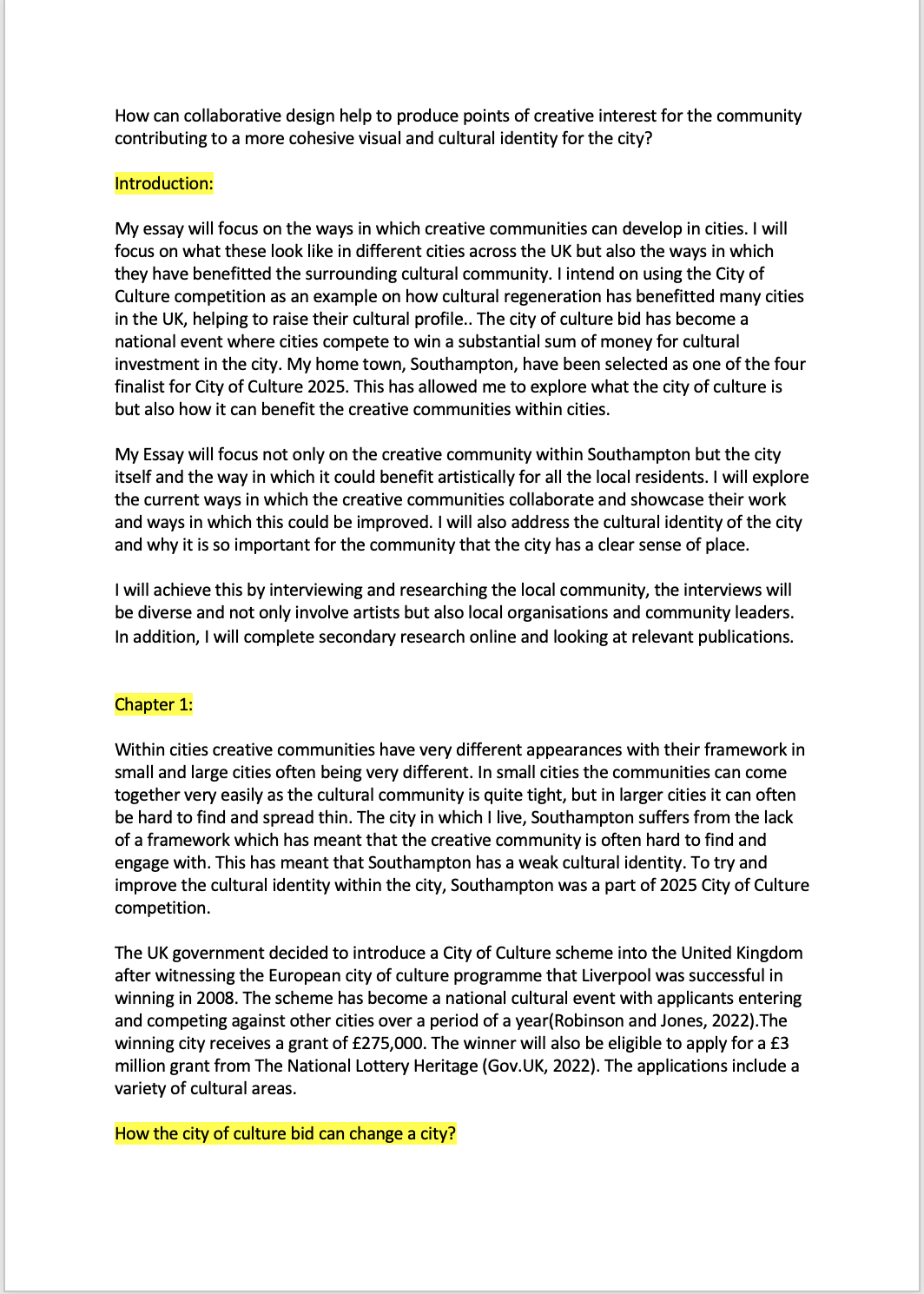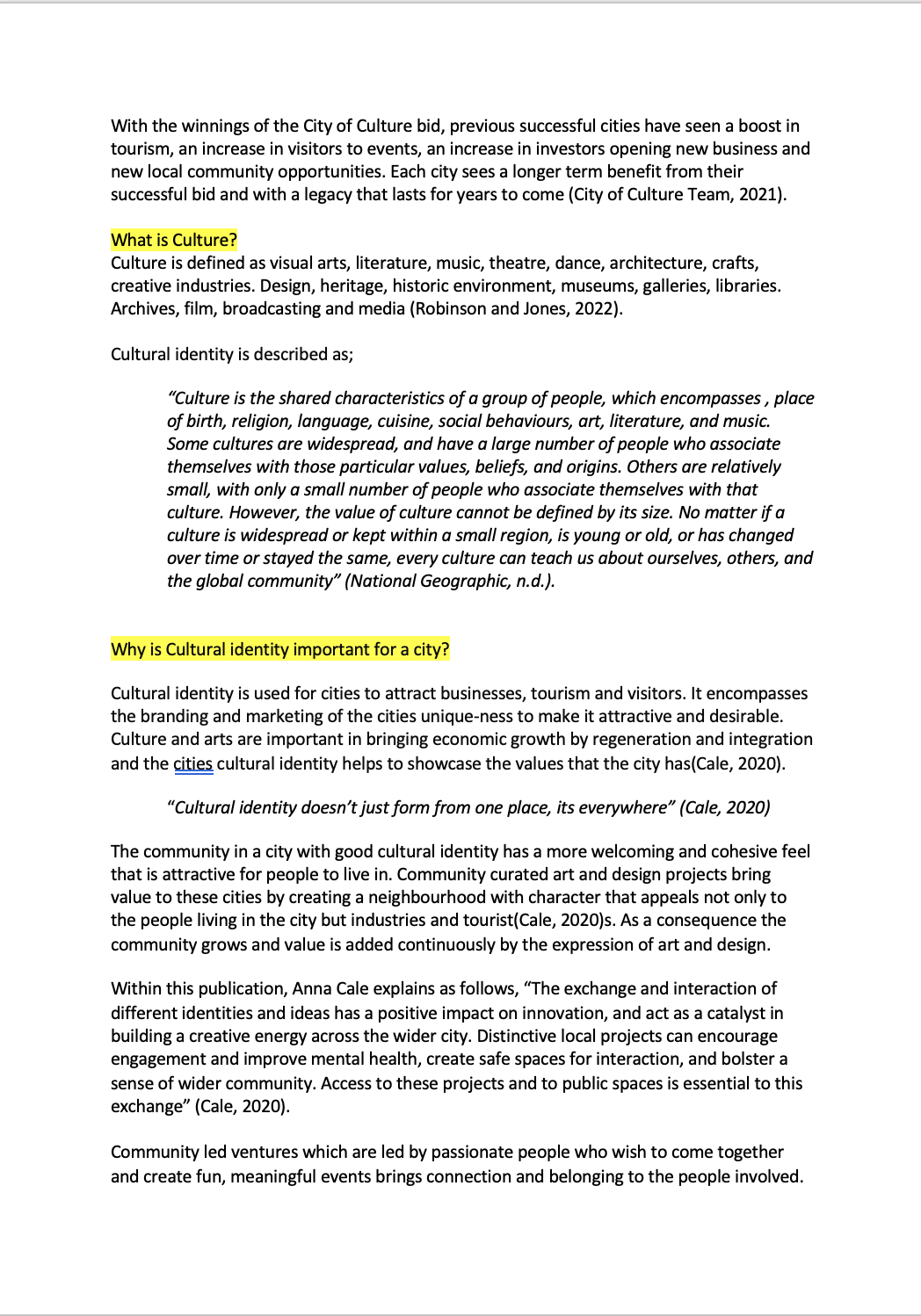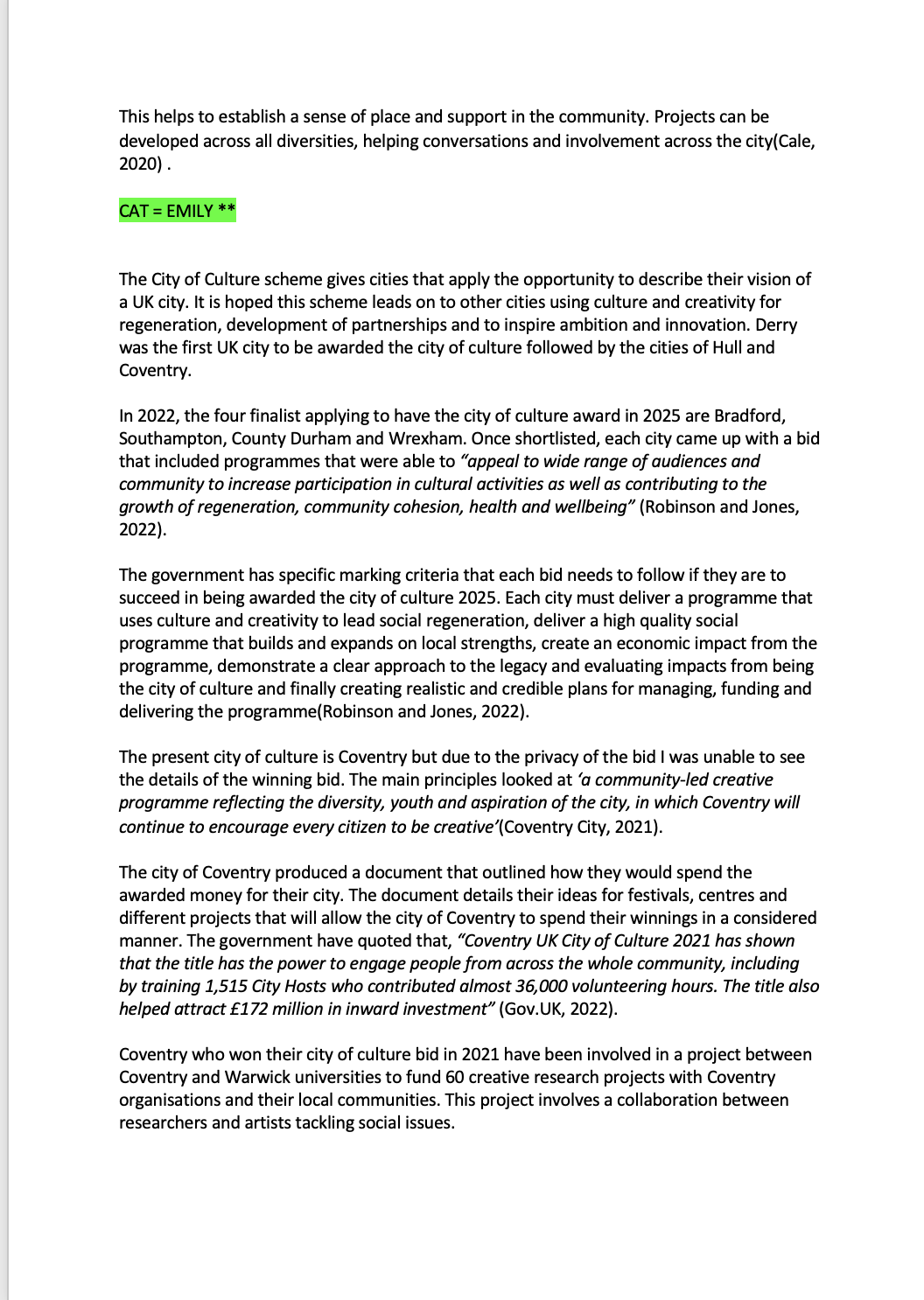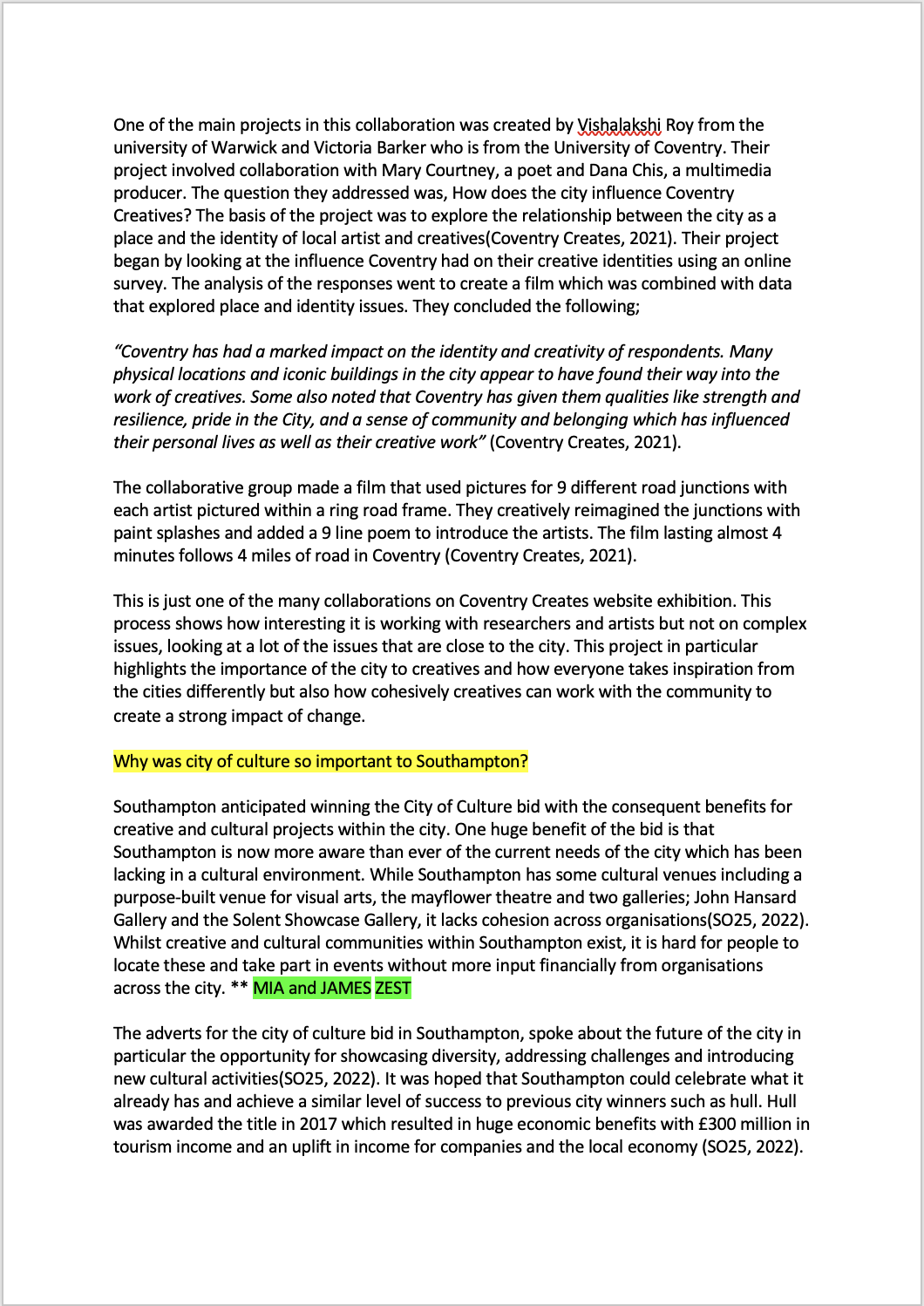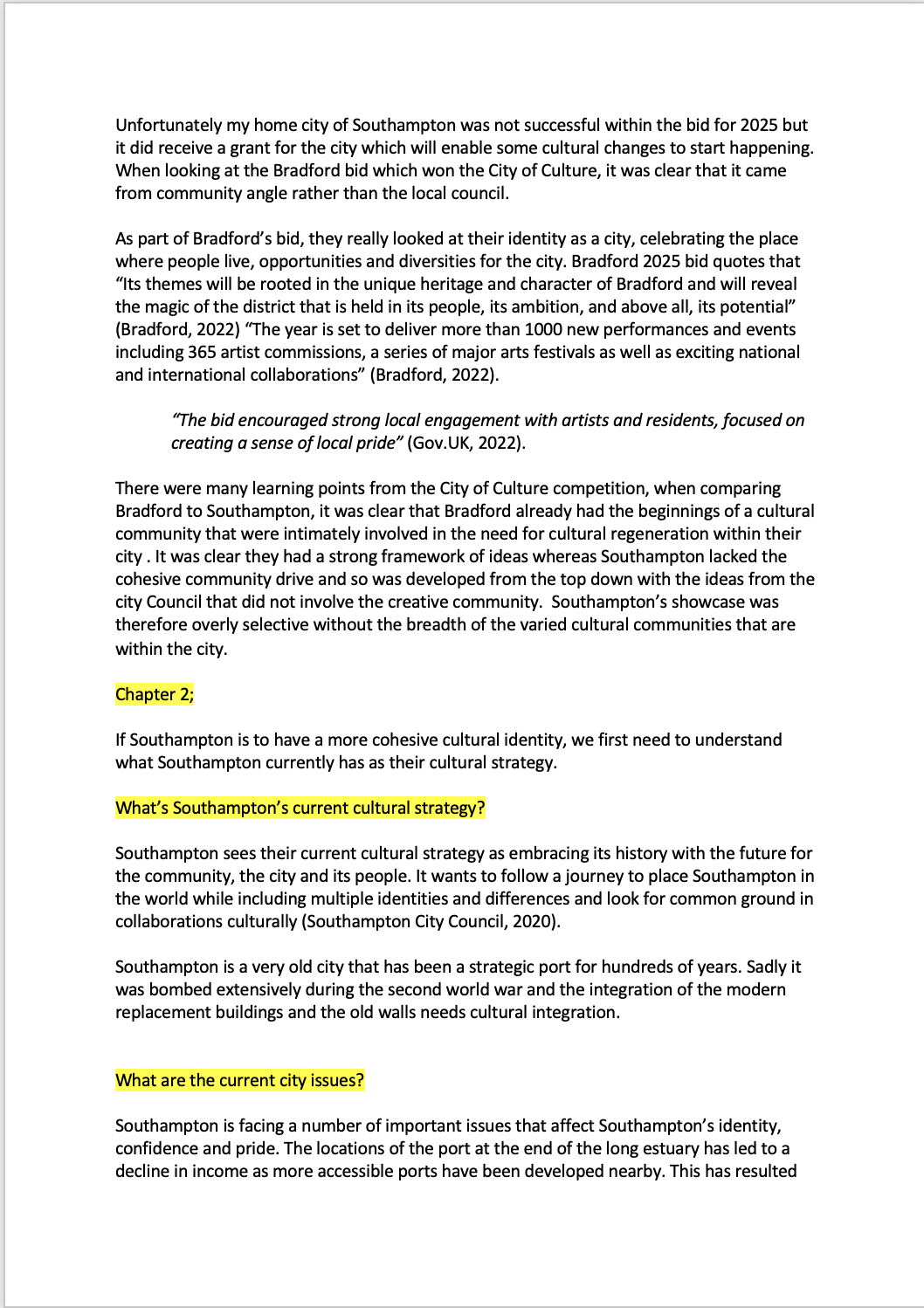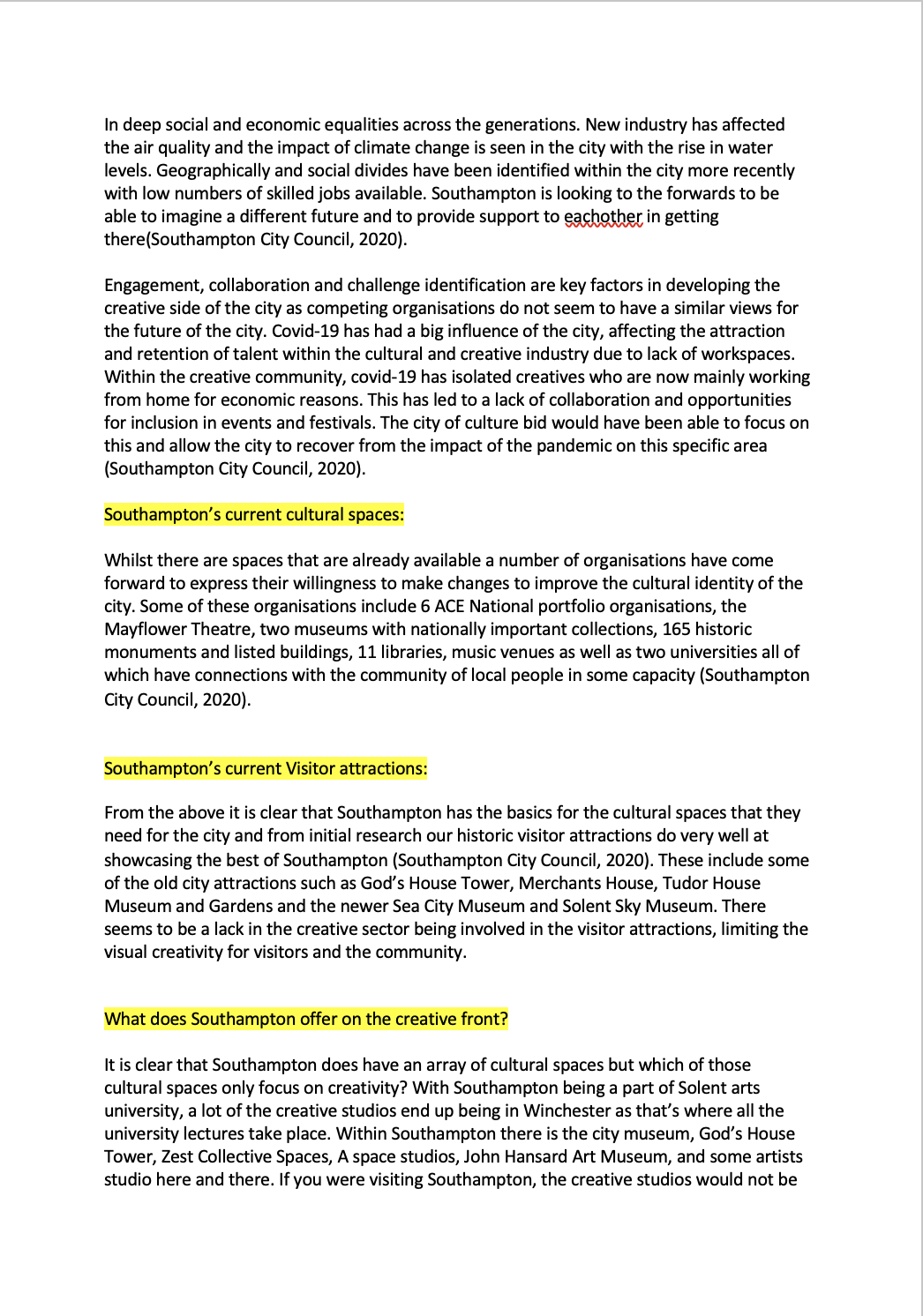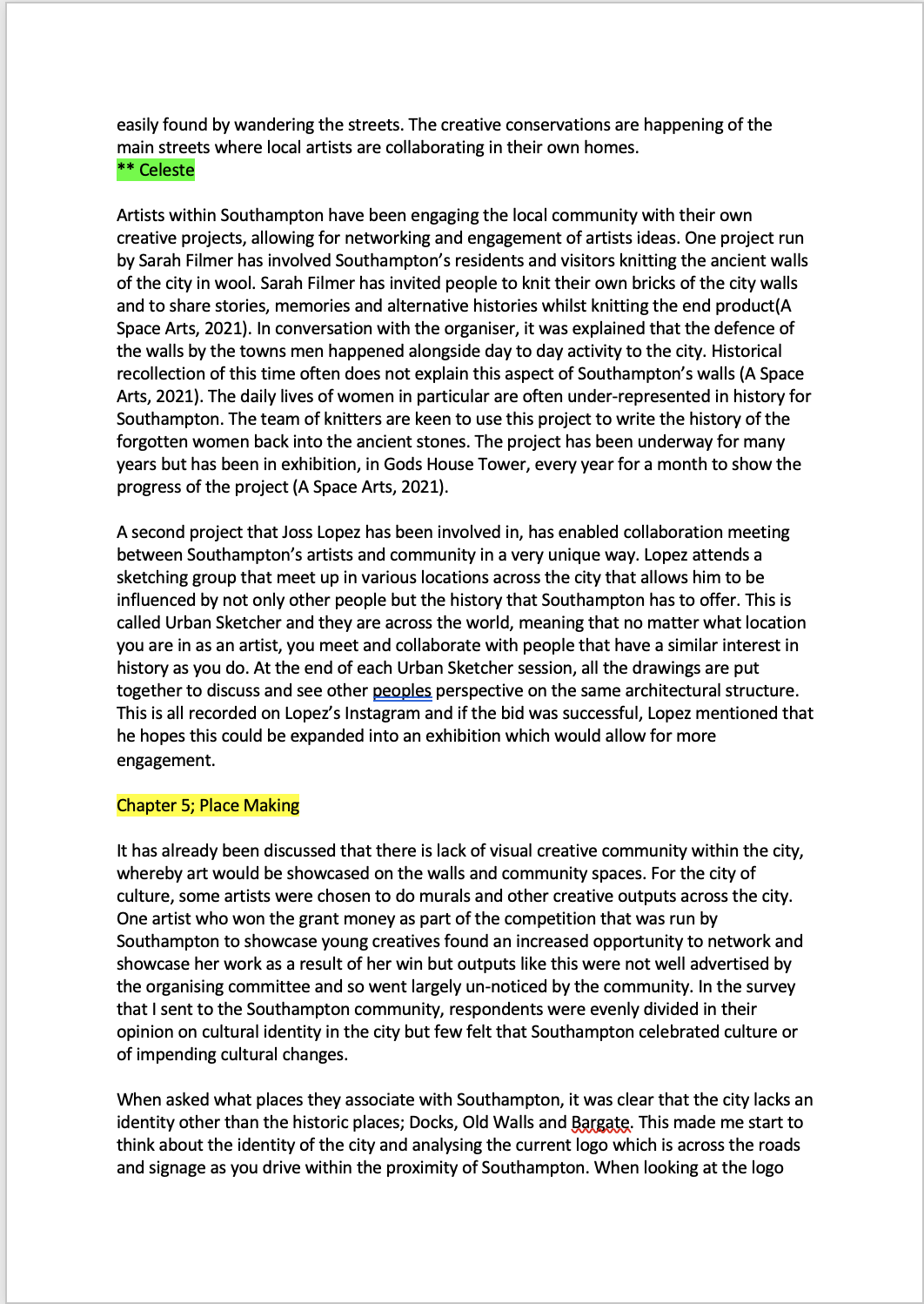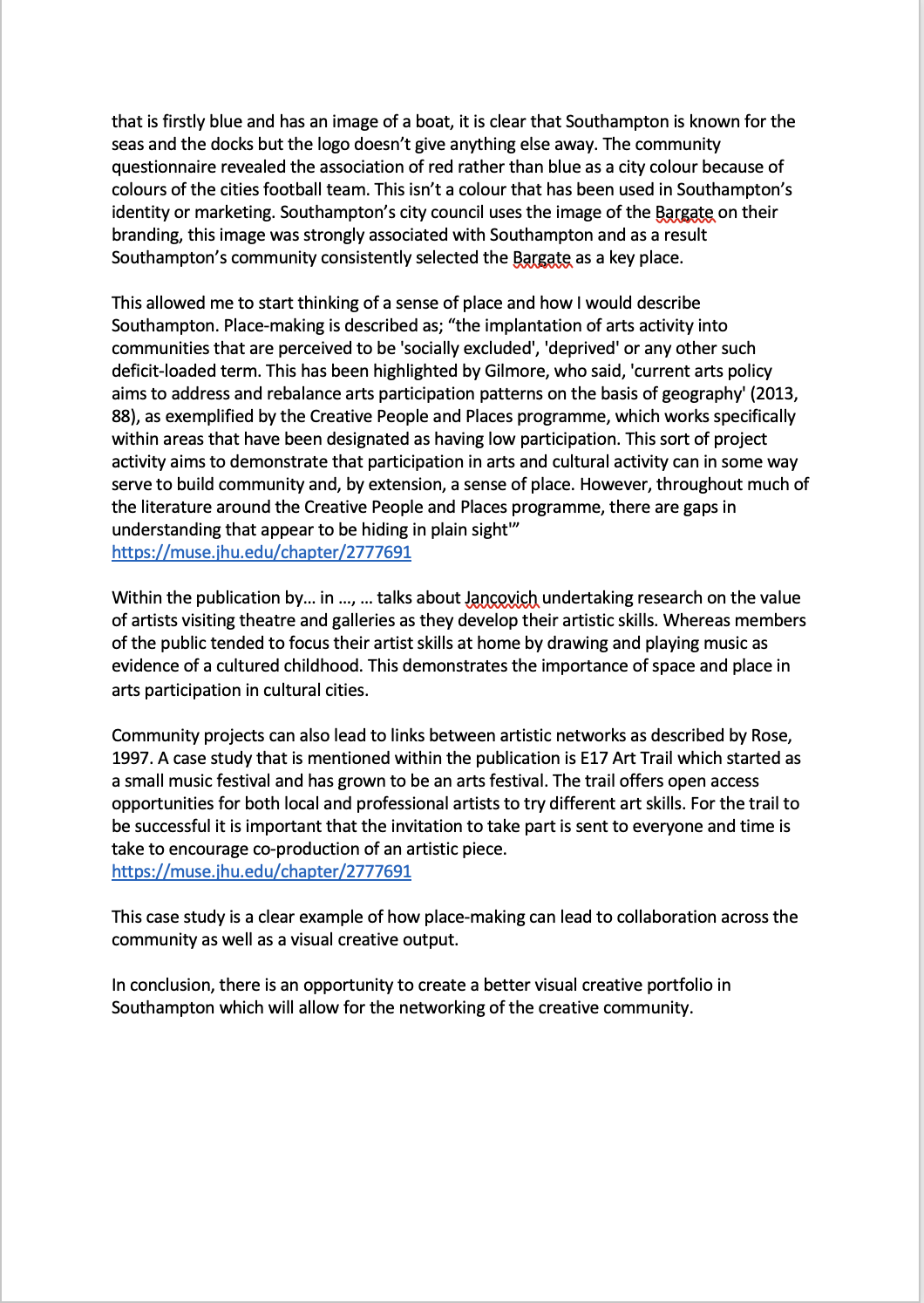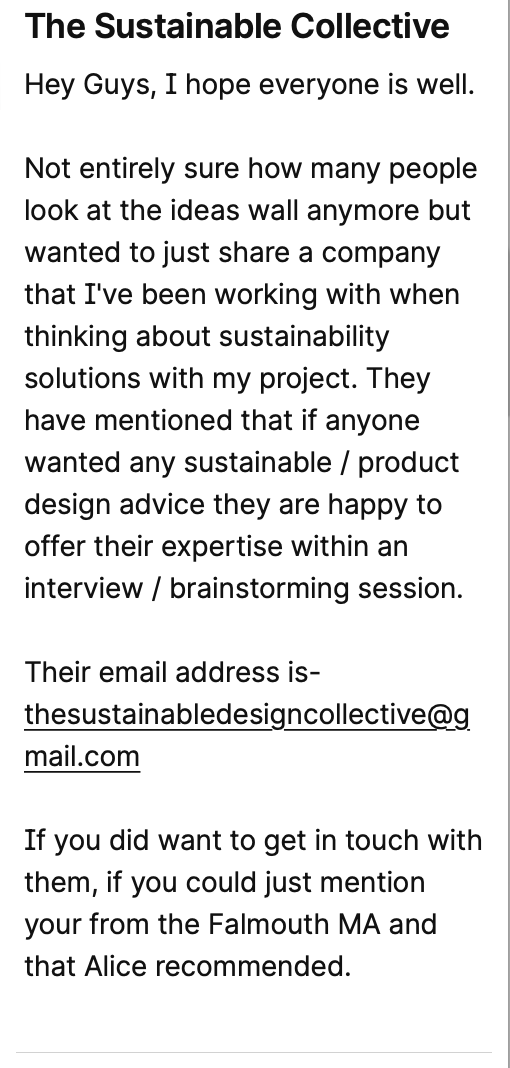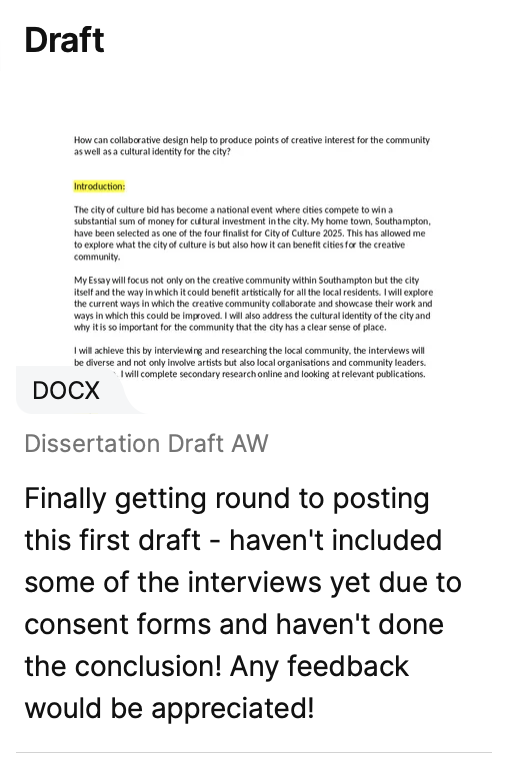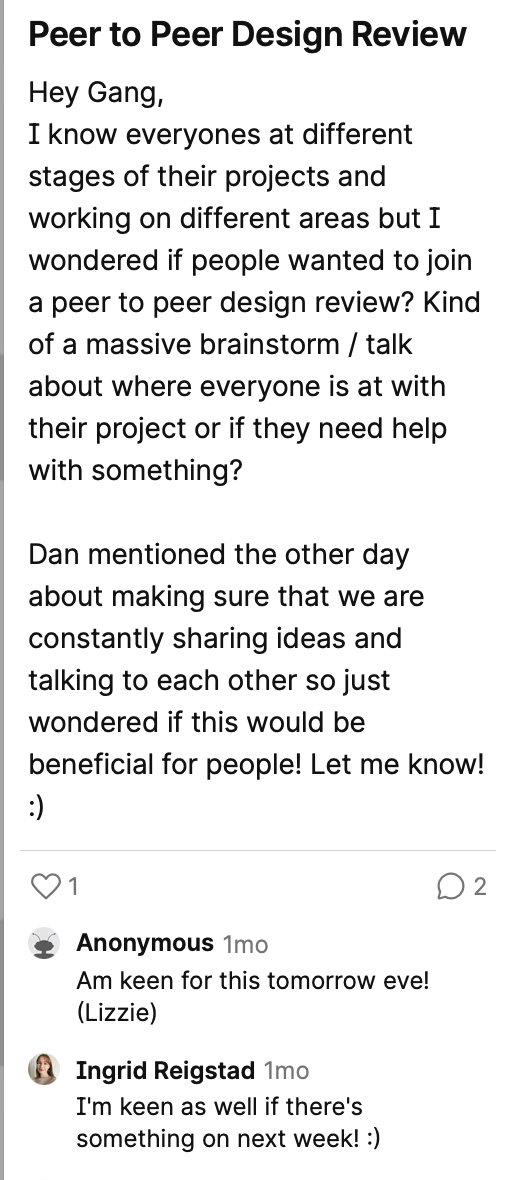Phase 4 - Weeks Thirteen - Sixteen
Week Thirteen
Weekly Focus:
The focus for this week will be analysing the results from the questionnaire as well as interviewing more people.
Questionnaire results
I left the questionnaire for a couple of days and was amazing by the 203 results that were given, it was an amazing response from the Southampton community! Not everyone answered every question but that can be given in a questionnaire like this, Below I will analyse each of the results given:
The results from question one are really clear, everyone has a different view of Southampton but they also partake in different activities, but the top three were the docks, old walls and bargate!
Question 2, I initially thought everyone would vote navy blue or light blue for this question because those are the colours that are already related to some of the branding within the city, but of course majority of the responses were red because of saints football team being red colours, there were also some responses for grey, which i thought was amusing as this was my initial response to the city too.
Question 3, the main answered symbol was in fact the bargate symbol. I took this symbol from the Southampton City Council logo so there is no question as to why everyone chose such a familiar logo, the logo was also blue.
Question 4, this result remained 50/50 the whole way through, but no just won the majority vote, but its a pretty even 50/50 split which was the most interesting result as I felt that no one did like southampton’s identity.
Question 5, the historic responses were also very similar to the places one with the Tudor walls, old walls and bargate the top three. Interesting as these three are also geographically located rather close to eachother.
Question 6, it was a clear no for people thinking that culture was clearly celebrated within the city, which was one of the main reasonings for my project.
Question 7, It was also a clear no for the people that were aware of the cultural changes that were happening to the city which proves that there isn’t a lot of information around or the information isn’t around for long.
Question 8, this was a surprising result to me due to there not being that many visible creative installations other than the murals I have previously analysed but this could potentially be in their whole life time which there probably have been more installation’s that are not still around.
Question 9, I was so happy with the amount of engagement I could with the improvements that could be made - I copied them all onto a spread sheet and then put them into a word document so they could be analysed more clearly - highlighting the ones that were of relevance to the project.
The following really stood out for me;
More celebration of art
Inclusivity
Better access for people
Personally I think we need to celebrate the diverse cultures more
More street art by local artists, more art around the city, clear signposting towards cultural venues, maybe a central digital hub that points you towards all cultural events and places
More mosaics
More arts, more street art/sculpture, more art galleries and creative events
Brighten up dull concrete buildings and walls
Genuine community coming together
Involve all communities by consulting them with variety of engagement activities
Highlight the beauty
Question 10, this result was was a pretty even split between parks and the southampton waterfront with westquay also following behind. I felt like southampton water front was a rouge answer to the questions due to southampton water front only being accessible in 1 place in the centre of southampton, the docks and travel take up a lot of the space so you can’t really access it.
Question 11, again I was so happy with the amount of engagement of this as it was just a box for anyone to put their opinions in but some people did make some valid points which again I’ve highlighted in yellow the ones that are relevant below but then I have also highlighted some in blue which I feel the need to comment on.
Some of the ones that stood out to me were the following:
Less football more art
Was an interesting place but has lost its soul
Great cultural opportunities but bubbling below the surface - not being supported
I don't think Southampton has much culture at all
Needs pushing more
It has so much unrealised potential
There isn’t a cultural identity which is why we didn’t win. The council are only interested in money, flats and the university.
We have nothing instantly recognisable apart from the Bargate which were not even allowed in. Waterfront and ships are irrelevant to people who live here now as it’s all private so not a good icon for a city.
More giant public art on the boring buildings of Southampton.
The following are comments that I felt the need to just comment on:
“Southampton is not just these locations”
For the questionnaire, I added the places that are within the centre of Southampton, I hadn’t thought about doing the art installation anywhere other than the heart of where all the other art organisations are that I have spoken too as well as the music venues and clubs. This may not be close to every cultural space but I feel that the centre of the town would be easily accessible for all visiting.
“Sadly, our cultural identity cannot be established overnight. It takes centuries to build an identity. I think we need to learn to appreciate what we've got and not knock it down in the name of progress or in favour of commercial pressures. Re-instating what we've lost previously, would also be a very good idea....”
This is a very valid point that Southampton cannot just establish an identity over night but I feel that this is the start, I would like my project and the response I create to be the domino effect of this new identity for the city that keeps on building.
“There is no single identity and that's a good thing. No single symbol can capture what Southampton means - yes the maritime angle is important but it's not the only thing - plus if we really want to celebrate that, we need more public access to waterfront: we probably have one of the least accessible and welcoming waterfronts of any waterfront city in the world!”
Completely agree with this comment, I understand that Southampton means a lot of different things which is what I was trying to grasp from the questionnaire. I feel that If i knew that the questionnaire was going to get so much response then I would have rephrased it to being able to type in the own question but I was trying to make it simple. The symbols that were chosen were personally the ones that I felt represented the city centre.
“Creative installations are all very well but again it's just the inner area. How about Riverside Park or Shirley Precinct? For instance. How about something different like a dance festival, or fireworks in other areas..besides the centre of town. How about encouraging music event for the various cultures we have in the city. We also need to make more of our rivers. How about some water taxis or pleasure boat rides. We can barely see the water and hardy use it.”
I feel this is another great point, that I feel that the city has seen some of the creative installations so my response needs to be more than that, it needs to be something that allows people to come back to the project and visit it over and over again.
“Re the penultimate question, would be nice to add a location of choice.”
I feel this was in relation to the where the creative installations were placed as I chose a small selection that were close to the town centre, If i was to do this questionnaire again then there would be a space for the own thoughts.
On reflection of the questionnaire, I felt people responded with what they would like to see changed within the city, majority of the comments spoke about the waterfront and how we could improve and gain access. I am sure that this could be approached within where I decided to base the installation for my project. I also feel that I need something more than just and installation that will keep people coming back. Maybe I am focussing on the art and design part of the project as my initial audience was artists and designers but maybe its more focussed on a creative response from different culture? This would be something I need to explore later on in the week.
Change of question
I added the draft report at the beginning of the week before analysing the results of the questionnaire and from the questionnaire, some people were saying that I can’t create an cultural identity over night which is completely true and I do feel I may need to change the wording within the question to make it more manageable.
How can collaborative design help to produce points of creative interest for the community as well as a visual cultural identity for the city?
>>>>>How can collaborative design help to produce points of creative interest for the community contributing to a more cohesive visual and cultural identity for the city?
Interview with Lidia + Simon:
Whilst still trying to gain a wider understanding of the city of culture and also how city’s work through an identity, I decided to get in contact with my cousin who is in fact part of the gov comms culture team and her boyfriend who worked on a project for the arts council. Due to the nature of the interview and their profession I decided to not post any of the recorded interviews online.
** this was the week that Southampton did find out they had lost the city of culture.
One of the highlights from there interview were; Lidia talking about the city of culture bid, “But I thought Bradford's felt really community led. So it felt like young people in the community were really, really involved. And they had a real focus on young people, it didn't feel like it was like, top down. So I felt like other bess that I saw not naming any names. It was very much like MPs council leaders were all kind of controlling the bed and have all the power, whereas it felt in Bradford a lot more grassroots. And like, it was quite separate from Bradford Council. I mean, they were obviously really involved. But the two one is kind of intertwined. There was one one visit I went on where we were literally showed around all day by the leader of the council, and then had lunch with MPs. And I was like, this isn't what city a culture is about. It's about the community and it's about people.”
“I think their main aims were to engage loads of people in art and culture and change the reputation of Bradford. So you talked about kind of brand, Southampton, for example of them having kind of a cultural identity. If that's really what I want to do for Bradford, they talked a lot about how kind of It's a city that never has the opportunity to tell its own story, its stories always told kind of by other people. And so trying to take all of that and not kind of being in the shadow of leads, for example.”
Another really interesting insight from the interview was the following from simon who was explaining how smaller towns feel compared to bigger cities; “I've done I've also done some work not for Arts Council, but essentially about what what people want from my local area, on towns on the south coast. This was in Hastings, for example. And it was it was it was a classic case of people wanting to develop, essentially the conclusions from the research of people quite keen to develop a regional identity, but weren't always sure what it looked like in Hastings is a town that is obviously somewhat in the shadow of Brighton. So Brighton had the effect of kind of absorbing all the more flamboyant and names are the things that resonate with the public more and more aesthetically pleasing. And it was an example of somebody that really wanted to develop a creative reputation, attract artists and attract culture that didn't know how they could make that their USP and I don't know, that could potentially overlap with someone like Southampton wanting to, you know, incentivize or, or essentially development developer a reason why artists should pick that as their destination to settle and set up studios because Hastings versus was an example somewhere that looks enviously to Neighbours was left and it's right that they felt we're doing a better job at absorbing people.”
We also spoke about margate, as this was a city case study that I researched in a previous module about getting the community involved with the regeneration of the place; “Margate is they this is what that's what adds your brows meaning when they look left and it looks brighter. They look right there looks a minute because Margate has done a very good job of essentially attracting artists and, and creativity through, you know, having its museums, but also being very cheap. And being well connected. And those are two things that Hastings actually how they got a good train lines of London, they've got the advantage of being on the cheapest areas in the southeast. So those are the things that need to come together for them really”.
The conversation about place and the artists on people was really interesting and allowed me to again look at my project through the eyes of different people. I think that alot of places are over shadowed or in some cases you only see what you want to see.
* For this interview I also didn’t want to post the transcript online.
Interview with Sarah:
This week I interviewed Sarah Filmer, who had been recommended by everyone I had spoken too so far. Due to the nature of the interview and their profession I decided to not post any of the recorded interviews online.
The interview with Sarah, we spoke about her background with being an artists in Southampton but also teaching at the local university. One of the key insights from the interview, she spoke about a collaboration project which challenged her, “I ran this project with six other artists, you know, really thinking, and that was artists from all sorts of different backgrounds. And, you know, we've never worked together as a group before. And basically, I had a nervous breakdown. You know, that's kind of, it's so difficult to bring artists together. I think that's one of the real challenges, because we are all so different. We have such different approaches and such different kind of desires.”
This was a real insight for me that I couldn’t just put artists and designers together without giving them their separate alley to work on something.
Another key insight for me was that sarah is and always has been a collaborative artists and she was really honest about how she felt, “I can't do anything by myself. Because I'm really, really insecure about my own practice, or whether it's that actually, that's just what I do is I work with people always. Yeah, I so I always do work with with other people. And yeah, bringing artists together is interesting. I think, I think there's some real basics lacking in the city, you know, there's no way to show your work. You know, and if you do do anything you have to do by yourself from your own energies, you know, it's, it's hard. And now I'm a trustee of a space, a space is one of the few organisations that does offer sort of genuine opportunities to local artists. But now I'm a trustee of a space is really different, you know, the optics are a bit tricky. “ This highlighted another problem that there was no way to show their work. This was a big insight for me as the designer on this project.
She spoke about her experience when she first graduated; “when I first graduated with two other artists, I opened some studios, which still go, unit 11 Studios, so that was great. And we had lots of artists come to that. And we did collaborative projects as a group all the time. And that was brilliant. Yeah, there was nothing else like that. And I think this idea of collaboration has become quite trendy. And so I think a lot of the organisations are working collaboratively with artists. Yeah. And quite often, I think that model, their model of collaboration is quite exploitative. So yeah, I think it's really, already negative. I'm really not at all. And I think the beauty of Southampton is actually, if you've got the energy and the time and the money, you could do anything you wanted in Southampton. But there's just, I mean, there's an increasing amount of infrastructure. But there's so much still expected of artists to do for nothing. Yeah. Not it's not a it's not a in our culture as a city to pay appropriately. “
“I think that's always been what Southampton's lacking is know where to go to find anyone else who's in the city, unless you know them already. And then you meet other people through them and all the rest of it. But I mean, I think the city of culture bid has, in some ways, made people more visible or made different projects more visible.”
She also told me about some of the project’s she’s been apart of which I would want to research more about later this week.
I feel the interview with Sarah was really eye opening to the amount of hardships of being a creative artist within a city where you feel that you don’t get a platform to show your work as well as being exploited and expected to do alot of things for free. There is also this lack of community feel amongst creatives and artists and knowing where to turn too. Leading on from Sarah’s comment about the city of culture making people and projects more visible this is what I want to continue to do throughout my project. ** For this interview I also didn’t want to post the transcript online.
CHAOS
http://www.chaosnetwork.org.uk/spotlight-wr/
As Sarah mentioned, I did some research about CHAOS, “The CHAOS Network provides space and time for creatives in Southampton to connect and collaborate”. This felt really relevant to the project so I had an explore of the website and found out one of the members of the CHOS website which is Katie Daley-Yates, who actually works with artists on projects in public spaces, from exploring the bit they wrote about her she has created a series on youtube with interviews on how public art is commissioned, there seems to be 3 different videos but I watched the one that had the best bits:
Within the Video it spoke to different artists about different commissions that have been achieved in a public space. Each of the artists explore some of the projects that they have been apart of but also what they do on the daily. One of the projects that were discussed was looking at how to bring something interactive to the project and how to include people in dialogue which again shows the importance of community engagement within the project. There was also another section that public art placement can either be in the best location or the worst location for engagement with people, this was also something I needed to consider within my project where would be best to place the Installations.
Another member which is shown is Will Rosie, who is known for being Mr. Mosaic around Southampton where he has created a trail of over a hundred small mosaics dotted around the city. ““Just for a laugh” Will started to put up small mosaics around the city, hoping to create a permanent art trail people could follow. “Everybody in the city fell in love” with them, he says, and Will now gets frequent private commissions from people wanting their own mosaic Mister Man or Little Miss. Recent recipients have included a park keeper and councillor, and these commissions help to support the work Will does around the city for free.” This trail concept is really lovely as the mosaics, I am assuming are something thats. really small, just something to brighten the day.
Knit the walls case study
https://sarahfilmer.com/#knit-the-walls-images-1
Southampton’s residents and visitors have been involved in an ongoing project to replicate the ancient walls of the city in wool. Sarah Filmer has invited people to knit their own bricks of the city walls and to share stories, memories and alternative histories whilst knitting the end product(A Space Arts, 2021). In conversation with the organiser, it was explained that the defence of the walls by the towns men happened alongside day to day activity to the city. Historical recollection of this time often does not explain this aspect of Southampton’s walls (A Space Arts, 2021). The daily lives of women in particular are often under-represented in history for Southampton. The team of knitters are keen to use this project to write the history of the forgotten women back into the ancient stones. The project has been underway for many years but has been in exhibition, in Gods House Tower, every year for a month to show the progress of the project (A Space Arts, 2021).
A Space Arts (2021). knit the walls - knitting in progress exhibition. [online] a space arts. Available at: https://aspacearts.org.uk/events/knit-the-walls
When Sarah was explaining this project, I thought this was the type of the collaboration project that allowed people to come together to talk and create something within a safe space to the spec of the brief.
Ribbon People
https://sarahfilmer.com/#ribbon-people-images-2
Another project by Sarah was ribbon people, this was a collaboration amongst friends, strangers, passer bys on this white wall in the centre of Southampton. Sarah talks about how she wanted people to engage in conversation with other people, where questions are asked and possibilities and perspectives are changed. The main reason for this was interaction, Ribbon people has since been into galleries and events but Sarah talks about on her website that it was best in the world.
I love this concept of allowing people to interact and engage with one another through something that is so simple.
https://sarahfilmer.com/#ribbon-people-info
Interview with Celeste:
Celeste was recommended by Mary who I interviewed a couple weeks ago. Celeste only works on particular days per week which is one of the reasons that It took a while to get in touch and speak to her. Celeste explains what she does in her roll at A space as the following; ‘So I work with a space doing coordinating studio projects. So it's working with the artists that the artists and at our house. Sort of, yeah, it's a mixture of like, the operations of the studio, so new studio members, upkeep of studios, all that kind of admin around fire safety, etc. So it's kind of building management stuff, as well as emphasis of like the community and what what can be beneficial for the community of artists, that the artists and that’
I initially asked her about collaboration from her perspective and how it works within the studios that she works with, Celeste said; “happens quite naturally, as someone joins the studio, and they've sort of hit it off with someone. And yeah, there definitely have been collaborations that have happened. And, yeah, I feel like there's there's always much more potential for like collaboration, I guess it's one of those ongoing things about the time that people have available or today, there's definitely, I guess, because I have a bit of an overview because I'm, I know, the artists, I'm working with the different artists, and some of the artists haven't even met some of the other artists that haven't been here, there for that long. So I kind of I guess I can see some of the crossovers and similarities and I mean, I don't want to be sort of, sort of, I feel like it's important that things that artists lead but I, I guess what part of my role, I organised sort of more social activities where artists can connect with each other, but more and it's the opportunity for those things to evolve. Like with Open Studios, which is once a year, which is the main event at the studios really sort of Yeah, wanting so yeah, talking to the artists about what what will be beneficial for their practice to do. Obviously, as an organisation we have things that are important from our side in terms of reevaluate staff and public kind of, yeah, kind of it needs to be a kind of meet kind of some of the targets within the organisations I speak about wanting to make sure that it's a useful thing for the artists to try something new in their practice if they want to, or Yeah, collaborate with someone else. And, and that definitely has happened within studios, for example, last year, there was a two artists there it was, it was both of their first open studio, because we had a bit of a break over the pandemic. And they did a workshop together. So one of them does primarily drawing and one of them was experimenting making inks out of different materials. So they did like a, an ink drawing workshop. So that's kind of a nice example of two people coming together to kind of support each other and just work together to do that. And, yeah, yeah, I feel like there's always more potential for people for more things to happen.”
From this she also said that some people have alot of connections outside of A space studios but then others really lack in those connections, I spoke about whether she would want to bring together everyone from the studio in some mass project and she replied, “I think that could be really interesting to do, I think, because that used to happen previously with I think, from the impression I got like 10 years ago, at Open Studios, they would it was a bit of a like, everyone put an exhibition together, find a thing and put an exhibition up. And I don't think that always went down so well, because people felt like they were trying to force something which wasn't necessarily working for them or people. didn't have time some people are doing live, some people weren't doing so much, which is always part of the mix in a way. I think some people would be really up for that there was one of the artists was trying to organise a group exhibition. Yeah, so So yeah, there's definitely some people were really up for that sort of thing. “
We also spoke about celeste’s work but also how she runs feedback sessions for artists and some of the work that she does with them.
It was a great interview with celeste that allowed me to gain a greater understanding of how an organisation like A space looks at working with artists which is then nice to compare to those who aren’t working within an organisation. I also really love the concept of open studios but i do understand that this might force people into working together which as Sarah mentioned in her interview, sometimes doesn’t go very well.
To read the rest of the transcript; https://otter.ai/u/TGsFzwEVzDQv78Ir_hKUj841AII
Design
This week ended up being a big interview week and with the draft and the questionnaire, I decided to leave the design part of the week to next week when there will be less research.
Critical Report Draft
I worked on the critical report over the may break and as I was still conducting interviews, I wrote up all the research I had done minus the interviews as I was still writing them up in the transcript.
Weekly Summary
This week gave me new insights into my project thanks to the questionnaire, I felt like I knew what I wanted to design and create before this week but now I feel that there is something different between this cultural installations or these creative ones. There could be a series of installations across the city and different times? I feel this would have to be something that I brainstorm in the upcoming weeks. The colour and symbol choices of the questionnaire have made it easier for me to start the design process of the branding side of the output. The interviews this week, especially with celeste gave me another layer or insight into what goes on within the city for an artist worker who’s also trying to produce creative work. Sarah also gave an interesting insight into how she opperates and works as an artists but also has all these other strings to her strengths, I found talking to her really honest and open conversation. I was also glad to get the draft report of the research done but I feel this was also turned into a research document.
Resources
A space (n.d.). Spotlight-WR – CHAOS Network. [online] Available at: http://www.chaosnetwork.org.uk/spotlight-wr/.
CHAOS network. (n.d.). Spotlight-WR – CHAOS Network. [online] Available at: http://www.chaosnetwork.org.uk/spotlight-wr/
Filmer, S. (n.d.). Sarah Filmer. [online] sarahfilmer.com. Available at: https://sarahfilmer.com/#ribbon-people-info
Week Fourteen
Weekly Focus:
The focus for this week was to walk the places and take pictures of the places that were apart of the qeustionaire, plan a route for the walk the installations and where the installations could be placed, explore the structure of the installations as well as research on installations.
Walk the City:
From the questionnaire last week, there were some of the top three locations that were popular for each of the answers, I want to explore the places that were voted for and see how they could house the installation.
The top voted places were the following, the ones with the * are the ones that were voted for twice.
docks
old walls**
bargate**
tudor house
old walls**
bargate**
parks
waterfront (may flower park)
west quay
Bargate:
Bargate is again a very central location and would be a great placement of the installations but there just again doesn’t seem to be that much space around it, there is also a massive footfall which is obviously a bonus.
Old walls:
The old walls snake around the side of southampton and there is some space on the side of the old walls. I was initially thinking that i could post things onto the old walls but I feel as its a historial monument I wouldn’t be able to do this. but there is plenty of space following around the old walls through the west quay esplanade.
Tudor House:
Tudor house is beautiful and a great historical location but there isn’t really again any space around it apart from this courtyard opposite tudor house as well as the space that follows from the walk from tudor house to mayflower park. Unless it was just one option I am not sure how I would fit them all in.
Waterfront:
The waterfront is only accessible from mayflower park which is where you can see the ferries and the cruise ships, as you can see from the images there is a good amount of space to house the installations and someone did say as feedback from the questionnaire, that Southampton are also thinking about getting rid of this space as it is unused.
West Quay:
The only place that you can really house anything around west quay is where they current have a bar / screen. As well as within the actual shopping centre. Other than this there doesn’t seem to be the space to have any installations.
Parks:
I already went through the parks at the beginning of the project, so didn’t feel it was initially relevant to do this again.
Docks;
The docks actually aren’t accesible to the public in any place. In a dream world part of the docks would be regenerated to house some cultural events - the only place that can house / you are able to access the waterfront is mayflower park which I took photographs above.
I went onto look at the locations and how they were related in terms of distance which I plotted on the map below.
I feel that they are pretty far apart being one end of the town compared to the other, now I feel I have two choices of how to progress with the placement of the installations to have them all within one place like all in the parks or to have a walking tour around the bottom end of the city which could end start and end in the creative places for example god house tower and the city art gallery.
I explored a couple of different routes that the walking tour could take from one end of town to the other:
I felt I couldn’t really picture the installation walk or installations yet though as I needed to determine the size of the installations and how many i wanted to place within the city.
Interview with Zest Collective:
I got in touch with Zest after it being mentioned within an interview, I got the chance to be invited to the beginning of the weekly online meeting where I spoke about my project, the tile concept and also how they found collaboration within the city.
A summary of some of the key insights are as follows: ”we so we it was one of our artists, Alex who did a workshop last year for our project size at the time, she made a workshop with I can't remember the community group, the youth on youth group. Yeah. And she went to them. And they did tile workshops, where they made tiles over a specific theme, I can't remember what it was. But then they she made a trail out of them for the exhibition. So it was old, long old, or the road where our studios are held and Robin came. Were the people that like place them all around. And then Alex made a map. So during the exhibition, all the artists and in the children everything could bring their parents and they would like do the trail where they go around and look around find find their trails, they didn't exactly where they were. And I mean are titles. So there is a very like it's a very fun way of getting people engaged. And very accessible as well plus, it's like they're quite flat. If you find like a good wall or something, it's very easy to like, make a board put them up on something and attach that board to said wall and you can move the board or something. Yeah, so it's like much more of a like it's very transportable.”
“murals are done by organised by segments showcase.”
“It's just it's just word of mouth, isn't it at the end of the day, like I love the idea of those of those tiles, but like, you know, doing them in like, artists coming to groups and going to workshops and doing them together, because it's like the conversations you'd get just from having range of like, crazy artists in the same space. It'd be really interesting. I think there's definitely Yeah, that should be it should be an ongoing project or something after so that you don't have a time limit. I think there's a lot of scope for it.”
“You'd like to call it our Hollywood Walk of Fame sort of thing where people got their handprints in it. Like, oh, this is here, although we're here for the thing. And you can recognise them. It's kind of like a quick fall, they fall they say you break the wall sort of thing or mould and you go start to do you find yourself meeting more and more people. And then when you come back to it, you're like, Oh, I know this person, I bet them and then you can see. Now you kind of like, have a flashback with what you're working towards should just be the tiles on the floor. So you walk on, like Hollywood style, your name underneath. And then lead it all the way to our studios.”
Within the session, we discussed my output of the potential tiles in different places across the city but they also suggested somethings that that were similar to my project including someone called Alex who was apart of zest. Which is some area that i need to think of, I think they have another really good point about creating a consistant workshop space where artists can continuously add to it, instead of it being a short installation that just taken down, which means I need to think about the longevity of the concept and how it would age with the space.
After the session, I was also invited and we spoke about the concept of running a workshop when I wanted to test my idea and how it would work. I jumped at the chance to test out my idea on a actually artists within the city, so I will plan to make sure that this does happen.
I recorded the session for my own memory purposes and the transcript can be found here:
https://otter.ai/u/pjFA0WlzsHevxd8somM1ecGgE94
Alex from Zest;
https://www.instagram.com/p/CSFXMGZor2e/?igshid=YmMyMTA2M2Y=
The only information I could find on the workshop was found on Zest Instagram account, where it looks like one of the artists ran a workshop with the youth group to create ceramic tiles which were then places as part of the exhibition. Which they then created into a tile hunt as part of gaining a prize at the end which is a lovely concept for a small youth group collab with an artists but also to showcase what Zest are able to do as an organisation.
Brain Storm with Artist:
After still being slightly confused about the direction of my project and how the concept would come together, I had a brainstorm with my Aunt who happens to be an artist, she runs different courses for textiles. I thought maybe explaining the project to her would allow me to see the weaknesses in the project. Below is the brainstorm:
Within the brainstorm, I still wasn’t sure what i wanted the brief for the artists to be, at this moment we were still discussing the artists responding to the local historical landmarks to create creative landmarks themselves, we also discussed placing the creative installations next to the historical landmarks. But from the above walk of Southampton, I think it was clear that this just wouldn’t have enough space outside every single one and how many is every single historical landmark? This also made me start to think about the main brief I would be giving the artists - Southampton through the creative eyes.
I was also still considering this personalised tile concept but how could this turn into an installation?
I think the next step for me was to try and research some installations and then start to sketch a lot of these concepts up which would then allow me to visually see the pros and cons of each but also were they engaging the creative community but also the general public? Were they responding culturally to what I wanted to create?
Installation research
I did some research on different installations but this also lead to doing research on Public art:
River Frames by PORT
Whilst looking through some articles on Dezeen, I came across this installation that draws attention to the history of the site, it describes the project as the following within the article; “ Set on a gravel walkway that outlines the footprint of the former Chicago Great Western Freight warehouse, which was demolished in the 1970s, are a group of steel-framed structures that "reflect the spartan warehouse structure that occupied Southbank Park for nearly a century".”
https://www.dezeen.com/2021/09/21/chicago-architecture-biennial-2021-installations/
I think I was initially drawn to the shape and the structure of the installation but also the metal materials that were used to make it see through.
Totemy, Poznań, Poland, by Alicja Biała and Iwo Borkowicz
https://www.dezeen.com/2019/12/06/six-installations-climate-change-crisis/
This installation is addressing a climate problem, they used climate change data to form the installation that is made of two different columns that represent different statistics. Within the article, they spoke about why they created the installation; “"We wanted to address the public at large, and at an everyday level," Biala said. "Passersby on the street and tram will catch out of the corner of their eye a flash of strong colours and be reminded of the current state of our world."
Viewers were able to access these explanations — and links to the' sources — by scanning a QR code on each sculpture.”
https://www.dezeen.com/2019/07/01/alicja-biala-iwo-borkowicz-totemy-towers-baltyk/
“Besides the plastic pollution Totemy sculpture, there is another dedicated to air pollution, one showing how much water goes into farming beef versus vegetables, one exploring over exploited fisheries and one that concentrates on wild animal populations.
Biała and Borkowicz chose statistics that would speak to Polish audience specifically. One Totemy sculpture shows the amount of annual global deforestation versus the total area of Poland — resulting in two sections of nearly equal size.”
“Biała, who is a visual artist as well as a designer, handmade all the sculptures with help from local woodworkers. She said her workshop was open to the community throughout the process, and every Saturday they would host a discussion and show documentaries in the space.”
The concept of this installation seems to have so many different layers that looks at different issues, the first one being issues that relate to the place itself, the second one being that it needed to be shown visually to show people the importance of the information that is being shown and the third is by including the community to allow for change to be made within their local area. This is a great example of of what I would like to create in response to my research question, a concept that has depth.
Oslo illuminated festival.
Another example of a place based installation, is the one that was put on in Oslo to celebrate being the european green capital of the year. Each of the projects were made using light technologies to help the visitors see their surroundings in a unique way.
https://www.dezeen.com/2019/11/05/light-installations-fjord-oslo/
“In order to keep the festival as sustainable as possible, all installations were powered using the city's existing power grid.
"The electricity grid in Norway delivers 99 per cent renewable energy, mainly hydropower," the festival's founder and artistic director Anastasia Isachsen told Dezeen.
"It was important to us to use grid power, and not diesel generators, which are often used in other festivals." "Fjord Oslo was founded with a wish to create a positive, inclusive, social and open cultural event for everyone in the city of Oslo," Isachsen explained.“
I really connected with the reasoning behind the installations, they were celebrating winning something for their city but there again are different layers to the project. The layers look at creating open cultural events for everyone, connecting people with nature and the outdoors but also showing oslo in a new light quite literally. I like that within this project people also had to walk around to different venues as well.
I found this talk on public art by Alex Chinneck, he talks about how he’s interested in different concepts. He talks about how important public art is for the public but also cultural availability to the public. Creating the illusion that the entire facade had been turned upside down, the key things Alex talks about is not on the aesthetics but also how it performs and how people interact with it. One of the things that Alex did at the beginning of his business was collaborate with different people within the industry, which allowed him to create a range of different projects. He also spoke about how we live in an era now which means that we have to make some of the concepts instagramable, which will appeal to the generation that can share the information of the public art for free which i guess has endless benefits. The main thing alex said in all the above was the culturally availability which really spoke to me within the public art, basically saying that this is free for everyone to witness and experience which I love the concept of.
NHS Public Art
https://www.itsnicethat.com/news/gratitude-wild-in-art-sculpture-art-300920
A project that is similar and seems to be trending within Cities at the moment are these sculptures that are showing awareness of something. The sculptures above are apart of a series that are currently paying thanks to the NHS which is making its way around the UK. Within the article it talks about one of the organising companies; “Wild in Art says in a statement that the installation “invites contemplation,” and is intended to be impactful and reflective. “We hope people can find a connection with one or multiple pieces,” adds Ben Reed, head of creative development for the producer. Contributing artist MrASingh comments that it’s “a nice opportunity for artists to showcase their gratitude through art and storytelling,” while fellow artist Jess Perrin says she sees the collection of figures as a symbol for “the community coming back together”.” I really connected with the reasoning’s behind this project as I think that everyone should have a free platform enabling them to showcase their artwork.
This led me to doing more research on wild in art, as they seem to have been used multiple times. From their website it is clear that you are able to take sculptures and then use them to engage with public artists. https://www.wildinart.co.uk/sculptures/
A quote from their website “ Wild in Art has proven experience in bringing all parts of a community together and giving them a voice through art. We design programmes that resonate with children and young people, the outcomes providing a unique insight into the aspirations, hopes, and dreams of future generations. Our learning programmes have engaged more than half a million young people so far.
Through our high-profile events Wild in Art provides a platform for amateur and professional artists to showcase their work. To date our events have contributed more than £3.5 million to creative communities.
“What characterises this new public art is engagement and participation. The walls between the elite who produce art and those who observe it are disappearing, and art has broken out. This kind of art is not something you choose to go and visit, it goes to make itself an audience.”
Demos Institute, Britain’s leading cross-party think-tank”
I didn’t realise that the institute was also raising awareness for the creative community but also I like how it talks about how it creates audiences instead of needing to target an audience. I would also assume by placing them in public locations that the public don’t have to go and find them, they are in your face so you look at them and admire them.
Morag Myerscough
WE couldn’t talk about public art without researching one of Myerscough’s latest project. Last summer Myerscough designed a sun pavillion which was created as part of Canary Wharf’s summer events programme. It is built from wood with metal awnings and the installation has a stage and seating that allows people to sit and meet others. It is described as a reawakening to a hopeful summer.
https://www.dezeen.com/2021/08/07/morag-myerscough-sun-pavilion-canary-wharf/
I always love Myerscough’s use of bold bright colours but also how she really designs for the practicality whilst making it beautiful to look at too. She really wants to make a difference to how people look at urban environments.
This made me curious to what else canary wharf was offering within their events programme especially as many of them were permanent. I ended up finding a page of all the public art that you are able to view within canary wharf. Although I didn’t find anything else that was especially relevant to my project, it was interesting to know that they had a lot that was available to the public.
https://canarywharf.com/the-estate/art-culture/art-on-the-estate/
From these case studies, I feel I have explored how projects have a range of layers but also the capabilities of what I am able to do with my own project. I feel there are two sides that I need to choose from over the up coming weeks; whether my project is a piece of public art or an installation. I wanted to understand what the difference was before continuing with ideation this week.
Design creation / Mock ups
To begin this design part of the week, I started by creating a pitch for each of the ideas that I currently had:
The Tile Concept:
I am still really liking the tile concept but even more so after speaking to the zest collective, calling it the wall of fame. I feel like more could be done with this idea but each of the tiles could be apart of something that is more permanent. I also feel that this is something that could be added too over time but also something that the artists feel like is their contribution to the city.
Igloo Concept:
The igloo is another idea that I like, I feel like if i was taking the tile concept a step further it would be the igloo concept, using the tiles to create these spaces that then inside could house exhibitions or workshops for the creative people of the city?
I also feel as this is the first step of the cultural changes, the installation space could be the first change and then there could be festivals or other cultural events that happen within the space.
The Trail Concept:
The trail concept is taking the previous and expanding it a little bit further without the use of the tiles, how could little installations house artist work that would be available to the whole community? I feel the trail is a great way that could also show exposure to hidden cultural spaces within the city. But i am unsure of the structure of the installations yet.
The Park Concept:
The park concept is taking the previous but just putting them all in one place - I feel this could also be done with the tiles and putting all the tiles in one area but having different topics for each and everyone.
Historical Concept:
The historical concept was infact my initial idea for responding to different historical importance within the city and having this historical aspect as that is what Southampton is known for but I think within my head, I’ve already cancelled this idea out and It is what Southampton is known for. its already visual - something else needs to happen that currently isn’t visual.
It was great to write down all the concepts that I currently had for an output for the project, it has enabled me to explore them in my head but also how they might look. I ran out of time for this week but the ideation and concept will continue in following weeks, including looking at a brief.
Weekly Summary
This week, it was great to talk to other artists about my concept especially talking to zest collective about the things they had done with the community but also what they thought of the city of culture. Exploring the installation and public art case studies gave me fresh inspiration for the different concepts and ideation that I will continue to develop in the upcoming weeks. I also need to start thinking about the interaction process but also what brief the artists will respond too.
Resources
Brewer, J. (2020). Artists invited to contribute to large-scale public installation thanking NHS and key workers. [online] www.itsnicethat.com. Available at: https://www.itsnicethat.com/news/gratitude-wild-in-art-sculpture-art-300920
Chinneck, A. (2015). Nicer Tuesdays: Alex Chinneck on Public Art. [online] www.youtube.com. Available at: https://www.youtube.com/watch?v=mvLW1UdvXGU
DavidCharlesFox. (n.d.). What Is Installation Art? Description, History, and Prominent Artists. [online] Available at: https://davidcharlesfox.com/what-is-installation-art-description-history-and-prominent-artists/#:~:text=The%20term%20%22installation%22%2C%20which
Englefield, J. (2021). Ten installations to see at the Chicago Architecture Biennial. [online] Dezeen. Available at: https://www.dezeen.com/2021/09/21/chicago-architecture-biennial-2021-installations/
Gibson, E. (2019). Six installations that call attention to the climate-change crisis. [online] Dezeen. Available at: https://www.dezeen.com/2019/12/06/six-installations-climate-change-crisis/.
Griffiths, A. (2021). Morag Myerscough brightens Canary Wharf square with Sun Pavilion. [online] Dezeen. Available at: https://www.dezeen.com/2021/08/07/morag-myerscough-sun-pavilion-canary-wharf/.
Hahn, J. (2019). Fjord Oslo festival illuminates the city with series of installations. [online] Dezeen. Available at: https://www.dezeen.com/2019/11/05/light-installations-fjord-oslo/.
Sabina Aouf, R. (2019). Climate-change data turned into colourful towering totems. [online] Dezeen. Available at: https://www.dezeen.com/2019/07/01/alicja-biala-iwo-borkowicz-totemy-towers-baltyk/.
Wild in Art (2022). Welcome to Wild in Art. [online] Wild in Art. Available at: https://www.wildinart.co.uk/.
Week Fifteen
Weekly Focus:
This week I want to continue to explore the different concepts and how they might work but also come up with the briefs and the process to how the artists and designers will come together but also how this might become a wider project.
Design creation / Mock ups
After writing out all the concepts within last week, I was really taken with this whole tile concept as I feel this is the one that could be the most collaborative.
I began to do brainstorming of how I could push this concept further and different ways of approaching it:
I felt like from this, I decided to firstly keep the installations in one place like one of the parks - this was also voted for. As well as this there were two ways that I liked to see the tiles those were one main stage / installation space surrounded by other responses from artists and designers so there being multiple parts to the brief but then also another way I liked the tiles was having them all as the same brief but doted around the city or within one circle. I also toiled with how that would look when combined but then also how can we play on the city of Southampton and the old walls and create a tile wall.
I also began to experiment with how the structures could look if it was a stand alone structure or within the main stage compared to the other components. This is an area that I feel i will need to either reflect on research that was done or look how other people have done it. There is also an element of how the tiles will be made to make sure that they are structurally sound when placed on the structure. Also there is an element of how they would break?
Structure research:
I went on to do some research on outside installations;
https://www.dezeen.com/2022/06/09/hermes-monumental-water-tower-structures-milan-design-week-2022/
Although the below image is clearly lanterns for Milan design week, I love the whole shape and concept of them and feel these could be adapted in some way to visually relate to my project. The exterior also look a lot like tiles and they have been able to create some interesting shapes. I never thought about having an enclosed structure, but more of a stand shape that was inspired by Morag Myerscough.
https://www.dezeen.com/2022/04/20/architensions-playground-installation-coachella-festival/
Another structure that I was interested in was this one which was at Coachella, “Architecture studio Architensions has designed a series of colourful, steel-framed towers installed at California music festival Coachella.”
The installation is called Playground which can be seen why, I love the concept of having some frame work open and then some closed but also how the different installations connect together with frame work. There are also a mixed used of materials and opacity to those which make it interesting for the user to interact with.
https://www.dezeen.com/2022/02/22/three-pavilions-rotative-studio-swiss-town-square/
“Architecture firm Rotative Studio has created three colourful temporary pavilions for reading and socialising in the Place du Marché square in Aigle, Switzerland.
Called Three Pavilions, the structures are designed to be "a playful intervention that could help revitalise the Place du Marché", a square in the middle of the historic town”
One of the main aspects to the pavilions that can be seen below are to make sure that the surroundings can be seen when standing within the structure. Again they have used mixed materials that are hardwearing but also colours that reflect the city and its history.
Another installation from milan week, was this one from hermes, which can be seen below, within the article it talks about the installation as the following; “The site-specific installation draws on the brand's known affiliation with bright colours and distinctive patterns.
"Colours and graphism are essential at Hermès, specifically in our textile, porcelain and objects collections," explained Hermès.”
Again this structure is good for inside but I do wonder how this would work externally and outside? But i love the concept of the colours and how that all goes together with the detailing of graphics.
Briefs
I also went on to brainstorm different briefs that could be set that would allow the artists and designers to respond to:
This led me to 5;
Favourite Colour?
How do you see Southampton?
What is Southampton to you?*
Favourite Pattern
Favourite Historical sight
I feel that one could be the main one and then there could be sub groups to the tiles or the installations that are used to create. I think what is Southampton to you or how do you see Southampton is a great question and I feel this was asked during the city of culture but wasn’t directed at the artists and designers in particular. I have also seen colour projects before and relating colour to different cities which I think is a great idea as its a very personal response as well as favourite pattern as I feel the artists could easily create this on the tile.
Colour your city
http://www.colouryourcity.com/about-us
A case study that i thought was interesting and related to my project was this one called colour your city, Colour your city is described as the following; “"Colour Your City envisions a world where colour is used consciously and imaginatively to enrich the built environment and elevate wellbeing. We see colour as a key element of urban design and placemaking, which can be utilised to help harmonise space, foster creative cities, and connect citizens, space and community. Colour Your City believes in dynamic, playful, interactive and intriguing urban space. “
I think that the reasoning behind this company really relates to so many things that I wanted to achieve within Southampton. They work on many different factors, including place - making but also research focussing on how they can open dialogue. I agree that colour is crucial to a city and it needs to be reflected in the same way.
Process
After deciding the above, I thought of different ways that the creative community would engage with the project or how the process of engagement would work:
I decided that a super simple engagement process would be good but also needed something that would be able to engage which could be a website? To be a never ending tile and to be something more permanent could be digital screens that run the tiles and they are changed every week?
I then went on to think about how this could be advertised.
This meant I was now thinking of the wider project and what else the concept should include:
Wider Project -
Advertising:
I feel the advertising side of things could be done on instagram but also to try and push the whole aim of the project is to physically visualise things, I feel that there needs to be physical advertising which of course could take place in the whole tile print aspect which would link back to the project. I feel this could also be done in eco form.
Website:
The website aspect to the project is important as this allows the artists to design and respond to the brief that they are creating.
Social Media:
I feel like social media is a great way that would allow the broader outreach of the project. This would also allow for the individual tiles to be shared to a platform with the users instagram handle and also potentially a quote from them explaining their design.
Festivals:
Creating a main hub space for cultural activities would be the first step in creating a visual space for the local artists and designers. The future of the space could hold festivals that could be run by local artists that would allow more responses to different briefs which would set up a wider space.
Workshops:
One of the main ideas for this project, is to be also be able to create a place where workshops can happen which is briefly explained above. These workshops could run of the back end of any of the creative organisations within the city. I feel being able to have a space that any of the organisations could use no matter if it was city run or organisation run would be a huge benefit.
Weekly Summary
This week has allowed me to really outline what I want my design to be and how I want to design it and what the purposes to the project would be. Over the upcoming weeks, I need to really start to visualise how the space would look but also how it would interact with the surrounding environment. Also starting to experiment with different structures to the space and how this would also hold the tiles. This is something that I need to focus on the upcoming weeks.
Resources
Dreith, B. (2022). Architensions unveils surreal steel-framed playground for Coachella. [online] Dezeen. Available at: https://www.dezeen.com/2022/04/20/architensions-playground-installation-coachella-festival/.
Finney, A. (2021). Hermès houses furniture collection in five boldly patterned installations. [online] Dezeen. Available at: https://www.dezeen.com/2021/09/22/hermes-furniture-collection-five-patterned-installations-milan-design-week/
Finney, A. (2022a). Hermès erects ‘monumental’ water tower structures that glow like lanterns. [online] Dezeen. Available at: https://www.dezeen.com/2022/06/09/hermes-monumental-water-tower-structures-milan-design-week-2022/
Finney, A. (2022b). Rotative Studio brightens Swiss city square with wooden modular pavilions. [online] Dezeen. Available at: https://www.dezeen.com/2022/02/22/three-pavilions-rotative-studio-swiss-town-square/.
Week Sixteen
Weekly Focus:
To make sure that I gain feedback on my essay and to continue to work on the essay.
Tutorial with Ben:
I really wanted to gain some feedback on my essay, to make sure that I was on the right track, I booked a tutorial with ben to help gain some understanding of the areas of improvement.
From the tutorial ben suggested that I needed to make more of a clear narrative of the essay but also make sure that I include the relevant insights that I had found out about the city from the interviews and the questionnaire that I had conducted.
I spent a lot of time this week, re structuring the essay which can be seen below:
Weekly Summary
This week really allowed me to get on top of the essay and to make sure that the structuring was correct. Also allowed me to see where i could put in some of the interviews that would allow me to have back up to what I was actually writing. Hopefully this will give me a good foundation, that I just need to lightly tweak it over the upcoming weeks.
Ideas Wall posts:
Over these weeks, I did post to the ideas wall multiple times which can be seen below:






